Like for so many, the covid years has had its impact on my way life that was hard to fathom until it happened. Almost overnight plans and lifestyles changed and, whilst certainly not the worst side effect, fishing at home and abroad was greatly affected. The 2020 and 2021 seasons felt like a slow awakening from a hibernation as anglers ventured out with caution, starting with the most local of venues and eventually feeling more comfortable with longer journeys, group situations and overnight trips again. So, after what felt like two long years with my boots on the ground my excitement grew to lead a hosted trip to the Icelandic highlands in July 2022 in search of big wild brown trout and Arctic char.
The two species are ones that I have encountered on numerous trips to the land of fire and Ice in previous years, and both I hold in the highest of regards when it comes to freshwater gamefish. There’s no question that brown trout have a loyal following that spans the globe; be that dry fly aficionados, technical nymph fishers or streamer junkies. Char on the other hand, probably due to their small global coverage, do not have the same following… although they really should. Yes, access to locations where char inhabit is limited but they fight every bit as strongly as trout, if not a little harder. They take a fly just as readily, possibly slightly less so a dry fly but they do enjoy feeding on the surface during good hatches. So, when char are a possibility you should definitely take the time to target them.
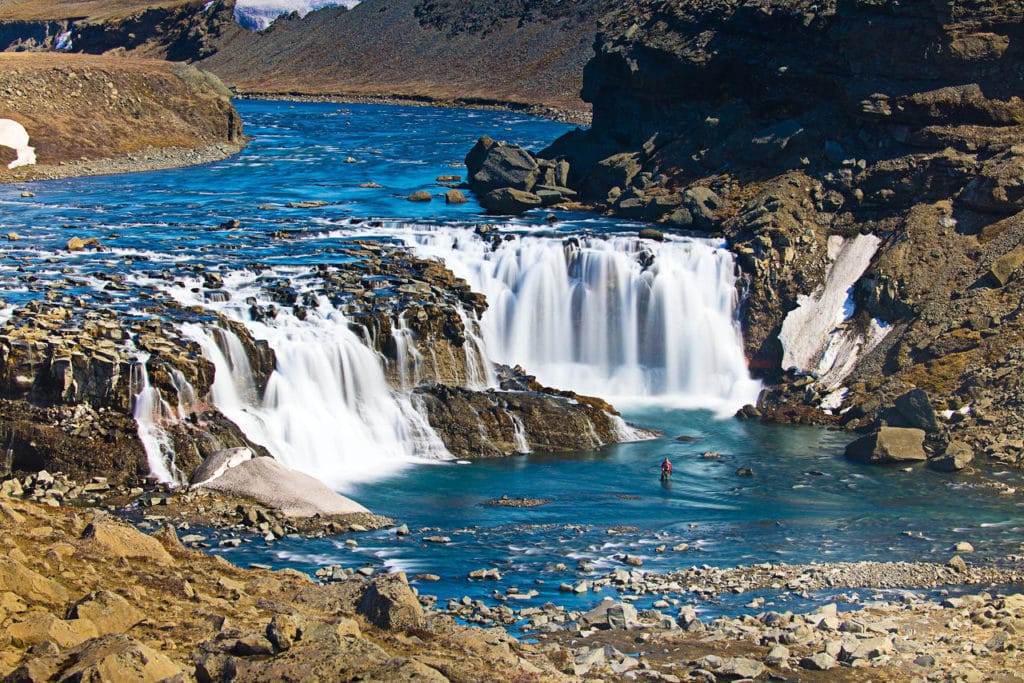
This trip was to take me to two new rivers in the southern highlands of Iceland, the Kaldakvisl and the Tungnáa. I love visiting new locations, learning the intricacies of these venues and trying to add the information gained from these places to complete the incompletable fly fishing puzzle. The joy with these two rivers is that they are fished from one lodge, a rare setup in Iceland, so less travel time and more time to focus on catching fish… hopefully.
Bags packed full to the brim with an assortment of rods, reels and lines. Countless flies and a heap of various clothing layers, I was ready to embark on my trip from Heathrow. Joined at the airport by Mark, Gary, John, Hugh and Tim, we set off on our Iceland Highlands Fly Fishing Quest.
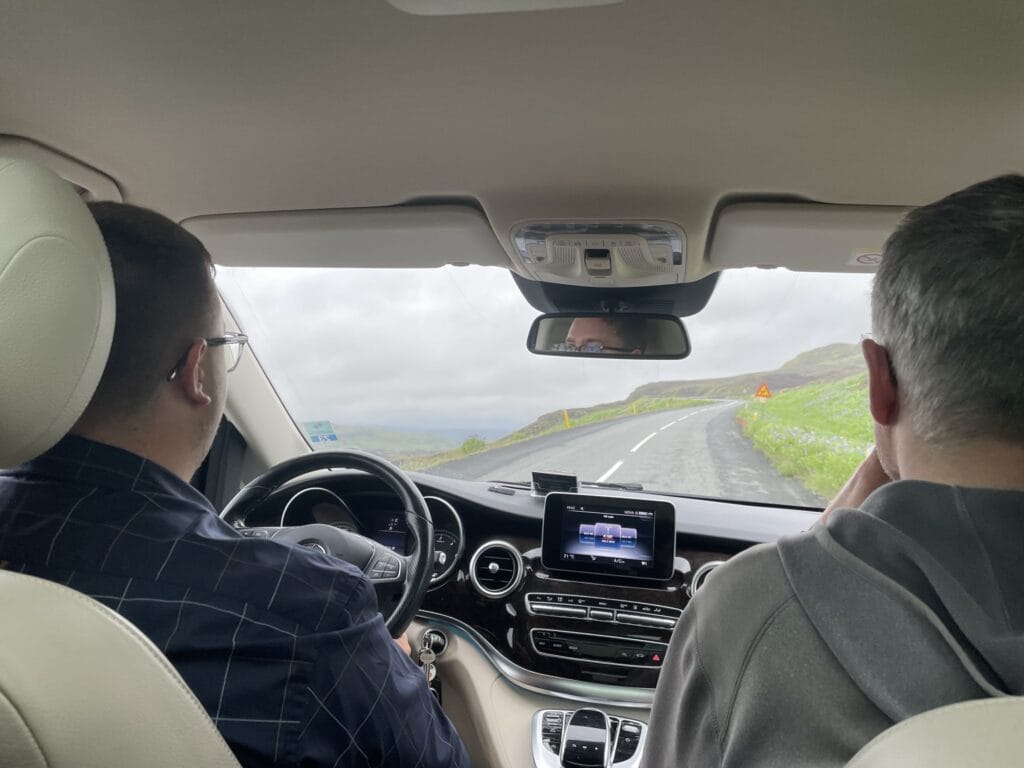
Navigating our way through Keflavik’s increasingly busy airport, we were greeted by Jon our driver and loaded into his minivan named Pac Man. A quick stop to stock up on Icelandic snacks, Hraun biscuits and Kreinur, we were on the road. The journey took two and a half hours as we navigated the southern coastal road, characterised by black cliffs, crashing waves and the country’s most recent “tourist” volcanic eruption Fagradalsfjall.
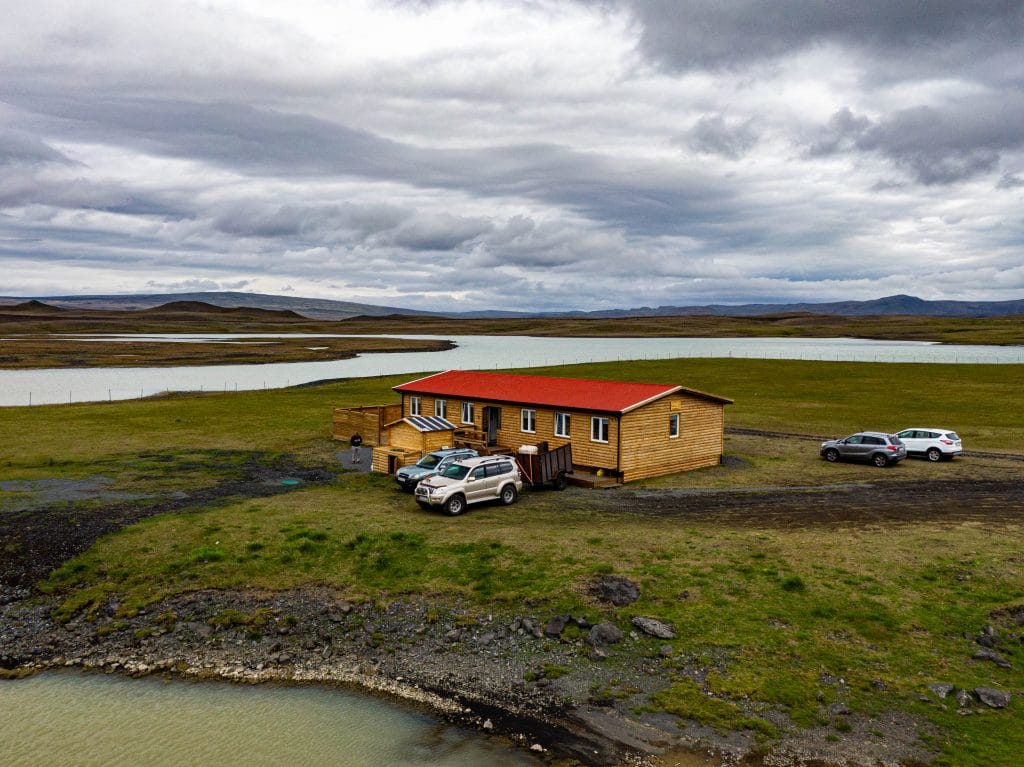
Arriving at the Highlands lodge, we were greeted by the lodge hosts Paris and Amelia who would take good care of us during our stay. Ignoring the howling wind and driving rain outside, we settled into our rooms and enjoyed a lovely dinner comprising of a ceviche char starter, Chinese chicken and noodle main followed by a wholesome portion of cheesecake. It was soon time to head to bed, before too much alcohol tainted our first morning on the river.
Fishing in a far more typical, 0900 to 1800 style, the morning wake up and breakfast is more civilised than the standard Iceland 0600 for a 0700 start. Tucking into our buffet style breakfast our guide team began to materialize in an array of thick woolly jumpers… an ominous sign on your first morning. It was windy but “better than it had been”, which offered at least some comfort. Nevertheless, an excited gabble of anglers congregated outside to rig up rods and get going, setting up on the leeward side of the lodge!
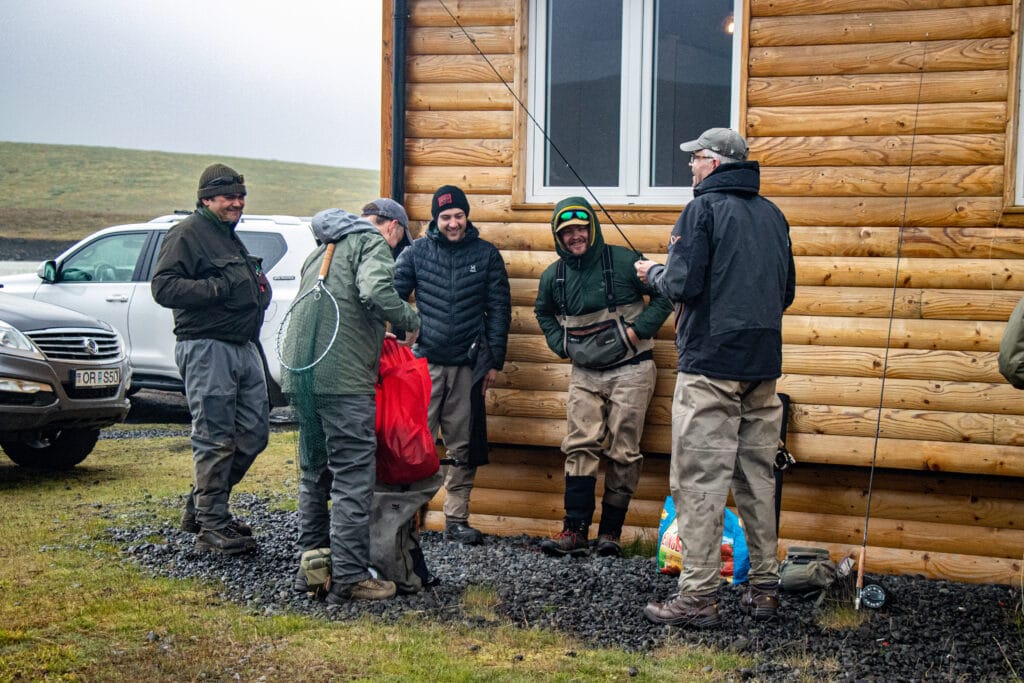
As a starting point, I went with two setups that would give me the ability to cover different parts of the river and cover large areas of water swiftly in search of hungry fish. Firstly, I had rigged up a 10’ 4 weight Guideline Elevate rod with floating line and a double nymph rig utilizing the New Zealand wool indicator to help give long drifts with heavily weighted flies. The second outfit was a 9’ 9” 6 weight Guideline Elevation rod with a Sink 3 15 foot tip line, 6’ fluorocarbon leader and a Martin’s Minnow streamer… on the nasty side but extremely effective.
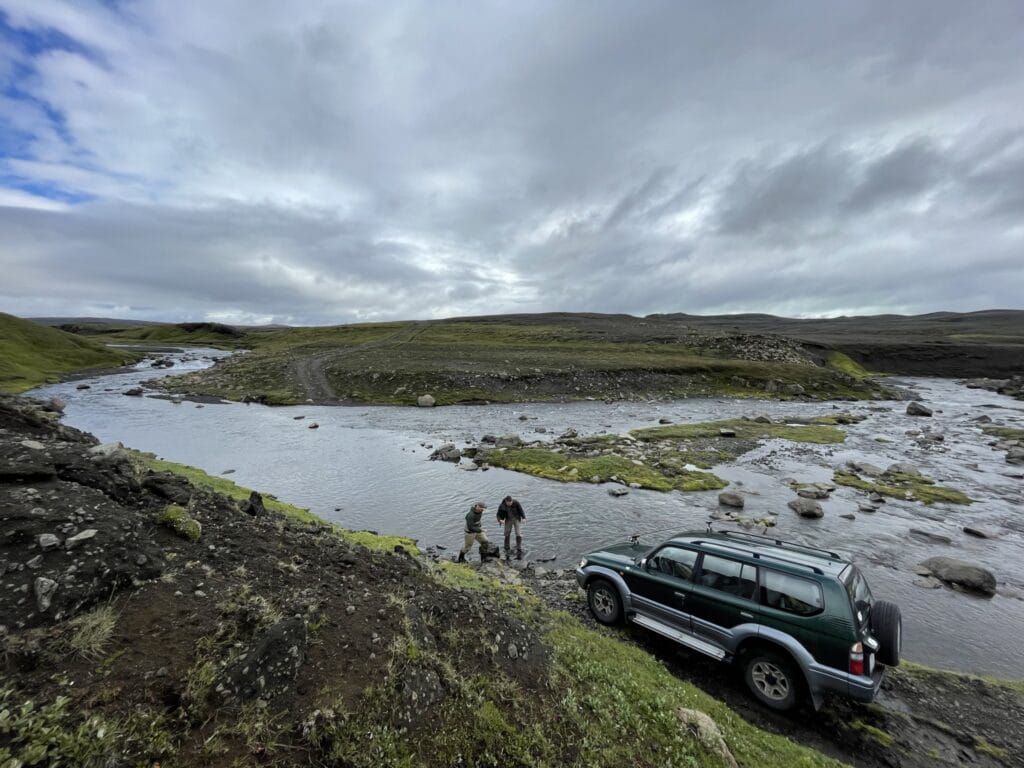
For my first day on the water, I teamed up with Tim and our native Icelandic guide Nonny to venture to the uppermost part of the Kaldakvisl. A bumpy ride across rarely driven highlands tracks, fording streams and rivers. Along the way, ground nesting birds took flight including whimbrel and golden plover, whilst Arctic skua glided menacingly in search of nests to raid. We reached a parking spot, high up on a rolling bluff of black lava sand, below us carved the seemingly black waters of the river framed by rich greens from shallow routing dessert plants seeking any moisture they could find. Periodically, patches of snow remained on the banks reminded you that in Iceland the word summer refers more to amount of daylight than the luxury of good weather!
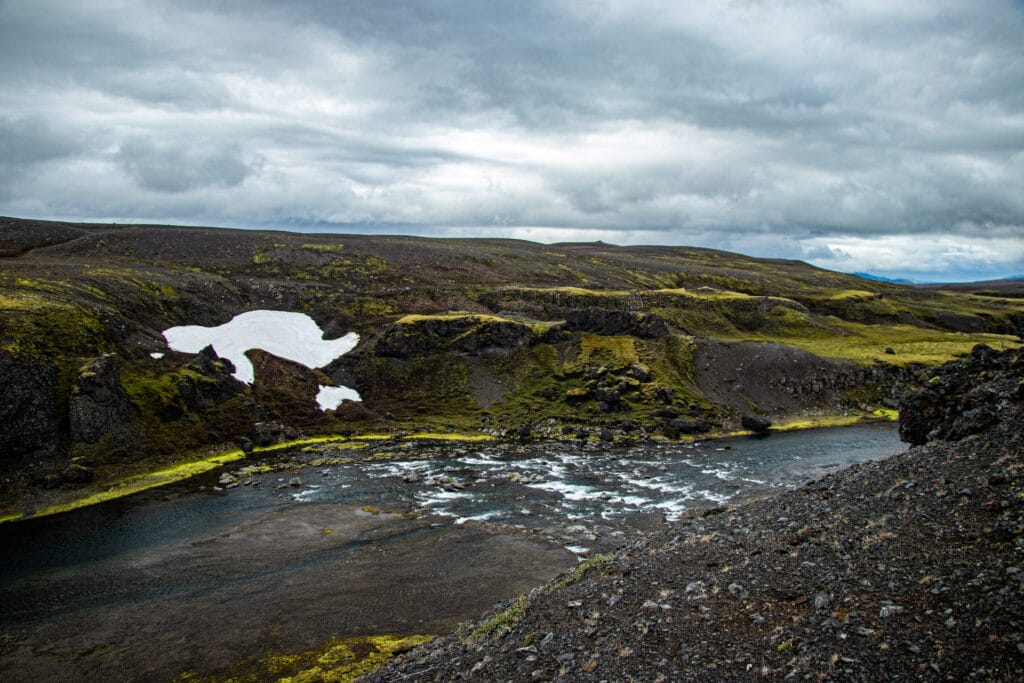
This stunning section of the river is called Ofan Nefja with three marked pools, 15-17. It is above a sizeable waterfall which is the natural barrier between this brown trout only section and the trout and char mixed water below the falls. This section of water cuts through a steep sided canyon, and as you venture up from pool 15 to 17, the sides of the canyon close tighter and tighter until it becomes completely inaccessible. Enjoying this terrain, a gyr falcon and her young had taken up residence of a high rocky crop with sweeping panoramic view. As we fished up the adult falcon’s calls rang out in alarm of our presence.
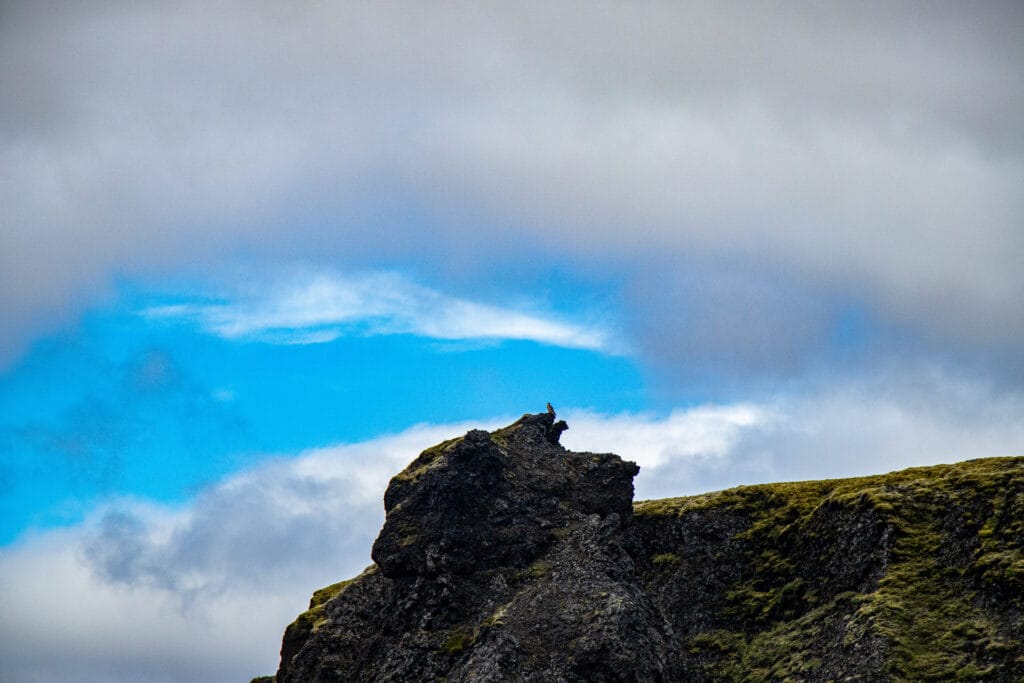
Leaving Tim and Nonny to work some lovely pools, I took to wading through the clear cold waters making prospective casts to areas I thought may hold fish. I covered a reasonable amount of water without success and started to question where the fish were, when all of a sudden a 4 inch trout swam straight towards me just feet away. I chuckled, it wasn’t exactly the size of fish I was expecting to see and left him alone in the hope that where there’s one, there’s more.
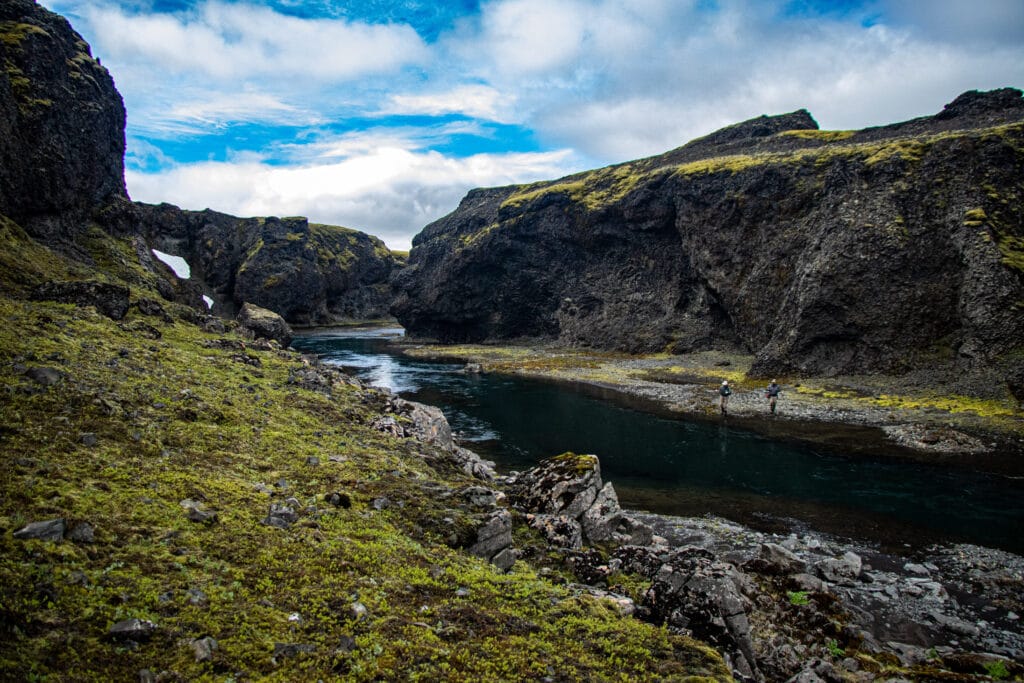
My prospective casts with the nymphs upstream had yielded little excitement by the time I had reached the pinch point of the canyon. Somewhat disappointed, but not to be deterred, I switch rods and began to fish my streamer rod back downstream. Casting to a rocky ledge on the far side and stripping the fly back, I hoped to see something move. As a neared the end of a run, I saw my fly pass over a rock and suddenly the river went golden as something went for the fly and missed. Heart rate now sky rocketing, I cast again. In the same spot a black and golden back appeared. Following… then bang! We were in. A strong chunky brown put up a mean fight in the swift flows of the pool neck before I was able to encourage it into a slow backwater and over the net.
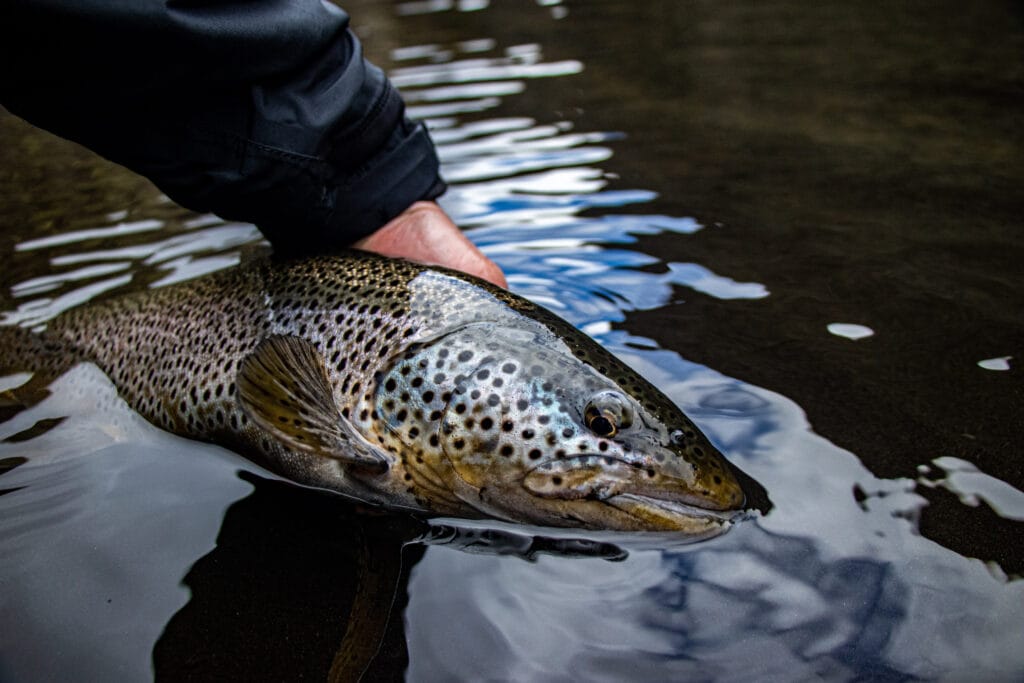
There it was, my first Kaldakvisl trout, 48 cm of prime prehistoric Icelandic brown. The uniquely dark and spotty marking that you only really find on the trout of Iceland, something of pure beauty. A quick photo and back to its beautiful home in the highlands.
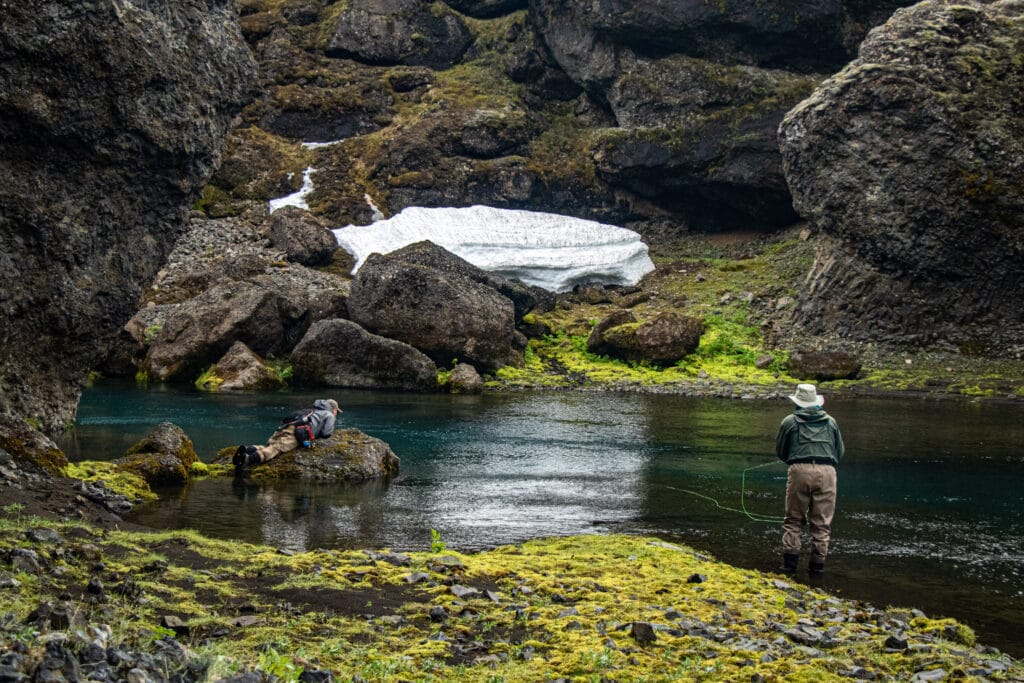
Heading back downstream, I found Nonny lying down and peering over a rock as Tim placed numerous casts to a trout they had found rising. Their efforts were fruitless on this occasion and despite a quick check back after lunch the fish remained uncaught.
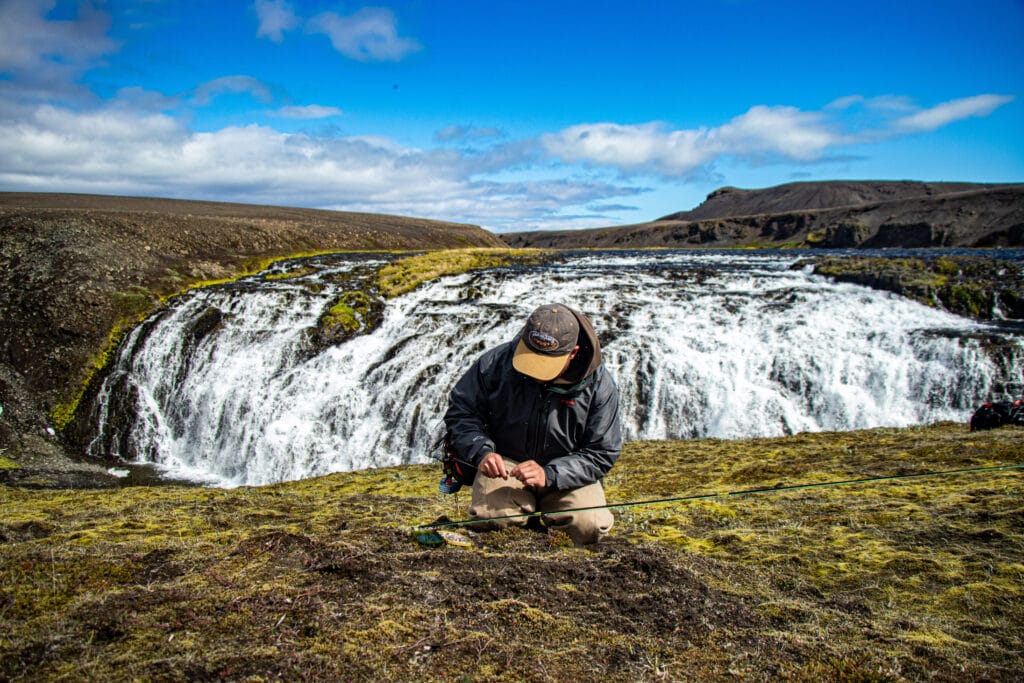
We then loaded back up into the car and headed further upstream to Fagrifoss and the uppermost numbered pools, 18-20. The sun had made an appearance, and with it so had the Icelandic midges. Whilst they very rarely bite, they are quite a nuisance without a bug net. I had a quick fish in the waterfall pools, and as beautiful as they were, I never really felt like I was quite getting my flies in the right place to catch. So, I hopped back out and found a high vantage point from which to watch as Tim and Nonny fished their way up the river.
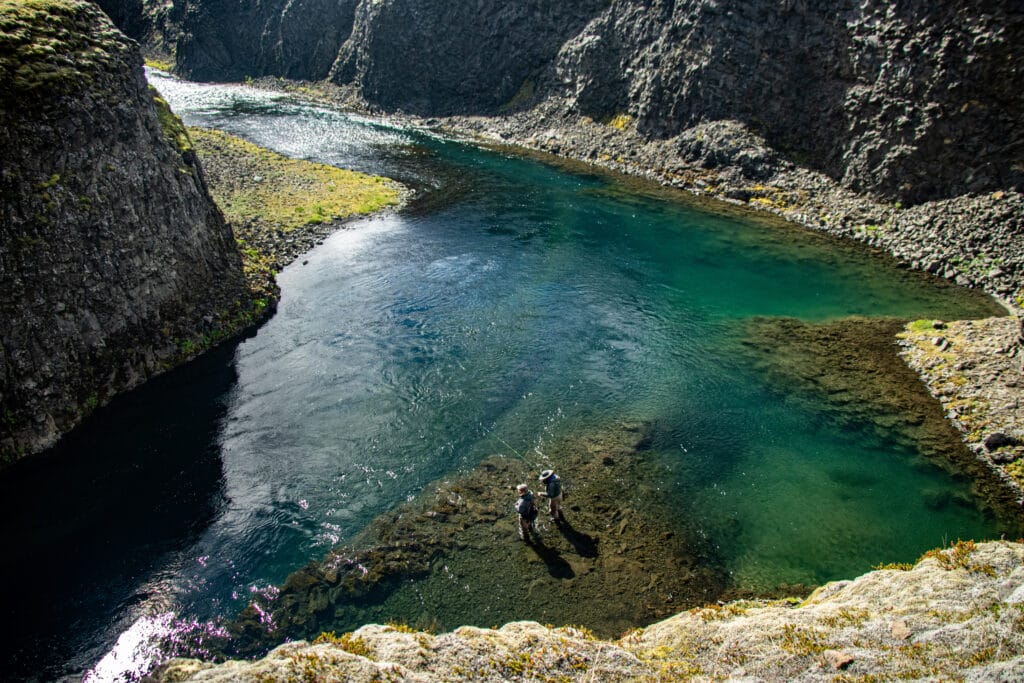
From my elevated position I spied a fish about 30 yards or so upstream from Tim. Shouting instructions down to Nonny to relay, I watched as Tim’s casts edged closer. Soon in range, I watched as the trout remained active in the stream. Once again I could feel my heart race increasing. Making a cast a bit too far the right, I called down new instruction. Next cast the line was perfect. Suddenly the fish ascended in the water. The movement only a feeding fish makes. I shrieked “STRIKE!”. Soon after the fish tore off and I could hear a screaming reel and two happy voices below. Scrambling down the bank I watched on as Tim landed a lovely 45 cm brownie.
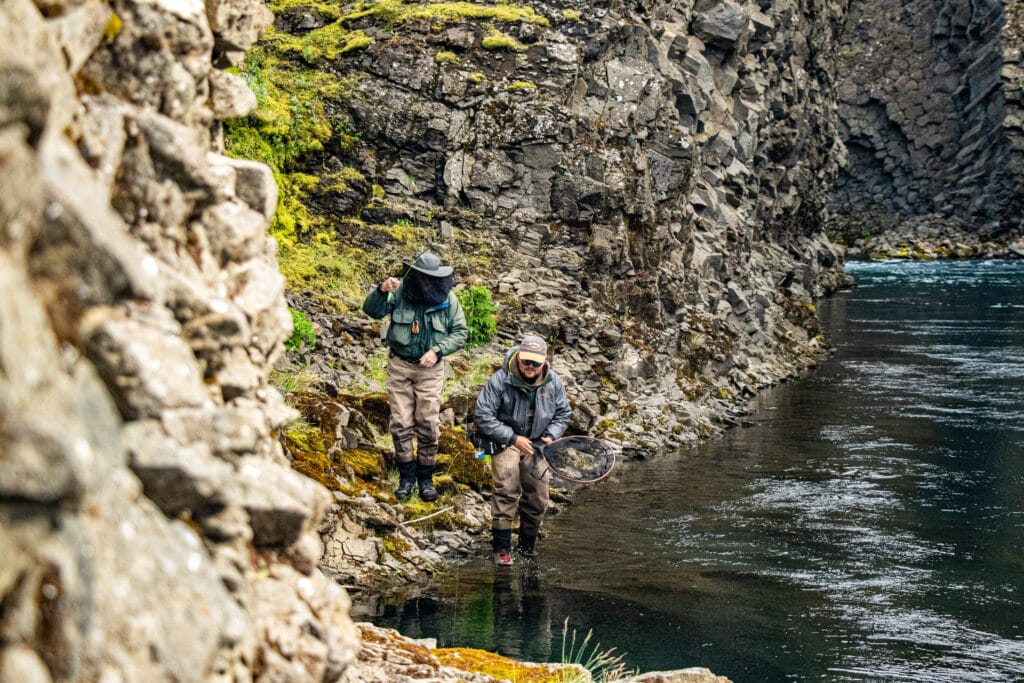
Shortly after, I was about to get fishing again to a trout I had spotted further downstream when Tim and Nonny called out again. Rock hopping my way up river, I arrived in time to see Tim land another fine trout, this time 53 cm.
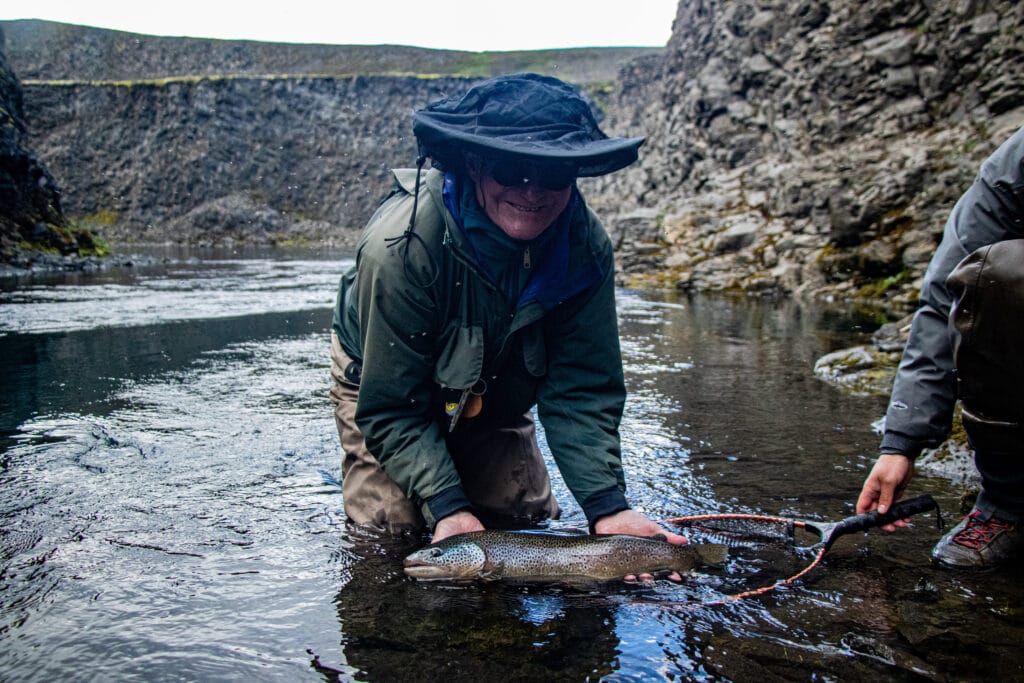
Our fishing appetite well and truly whetted, it was time to head back to the wind sheltered lodge for a cold beer, a warming glass of wine and another lovely meal by Paris and Amelia. All the group had been in contact with fish, with John being the only one to land a char on day one.
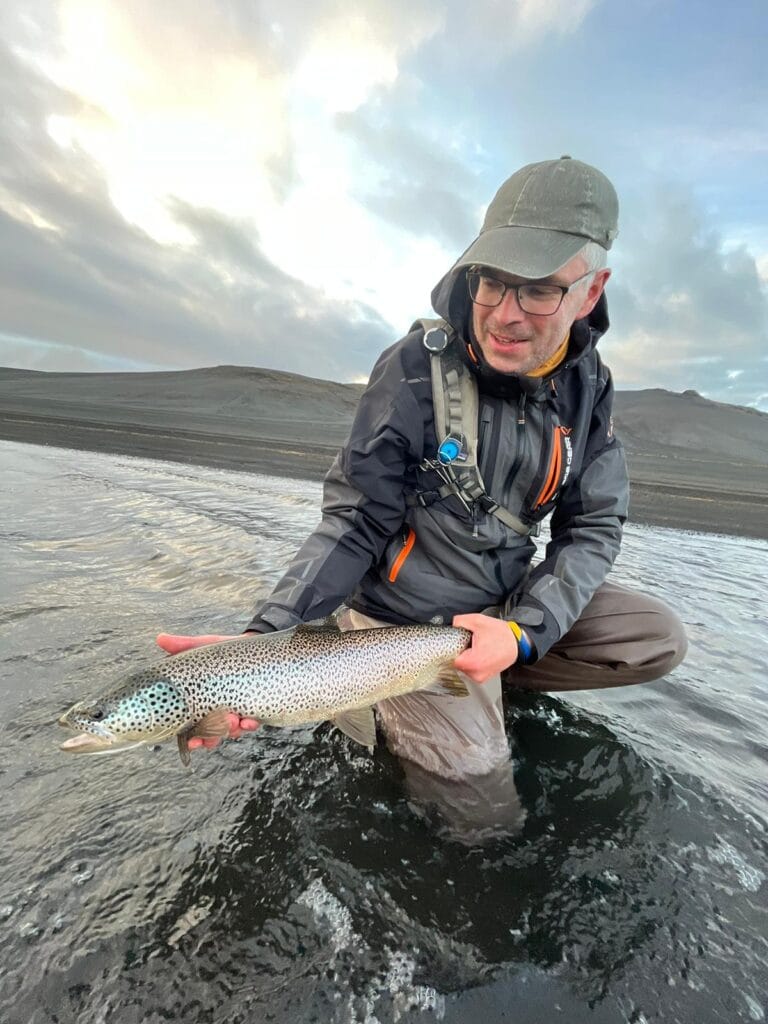
The day was not yet done though, the guides keen to get their own fishing fix for the day told us they were heading to a nearby lake, Fellsendavatn, known to hold monster brownies. The hour or so in the late-night half-light brought about a couple of lost fish and Mark taking honours with a fine 67 cm brown trout to make the outing worthwhile.
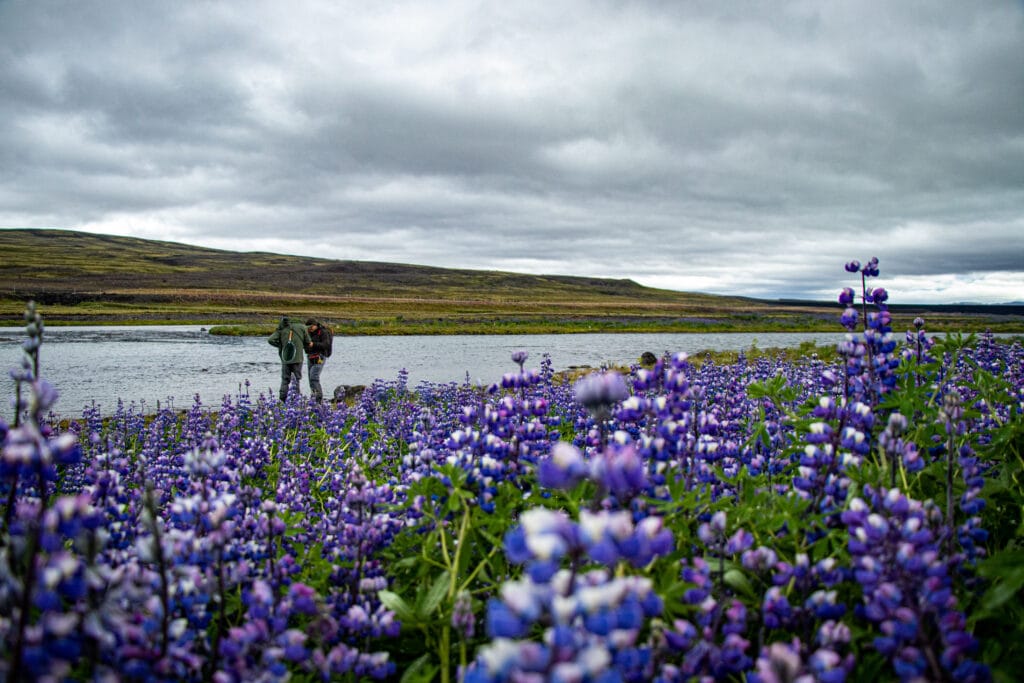
The next morning, the unkind wind from the day before had strengthened further. Nothing that an extra cup of coffee couldn’t provide the courage to take on. Today I teamed up with Hugh and our guide was Robert, a charming outdoorsman who made sure we had fresh coffee available at every opportunity. This time we headed to the Tungnáa, an interesting tailwater running clear but with a greenish/blue colour over far more fertile ground. Its banks are thickly lined with vibrant lupins and the birdlife is more varied with the addition of agitated red-legged phalarope and busy Arctic terns.
The river showed signs of its variable flows, as large pebble banks rose at various points in the river creating interesting pools and at times numerous channels. It is an ever-changing environment with new pools born each season to keep the guides on their toes.
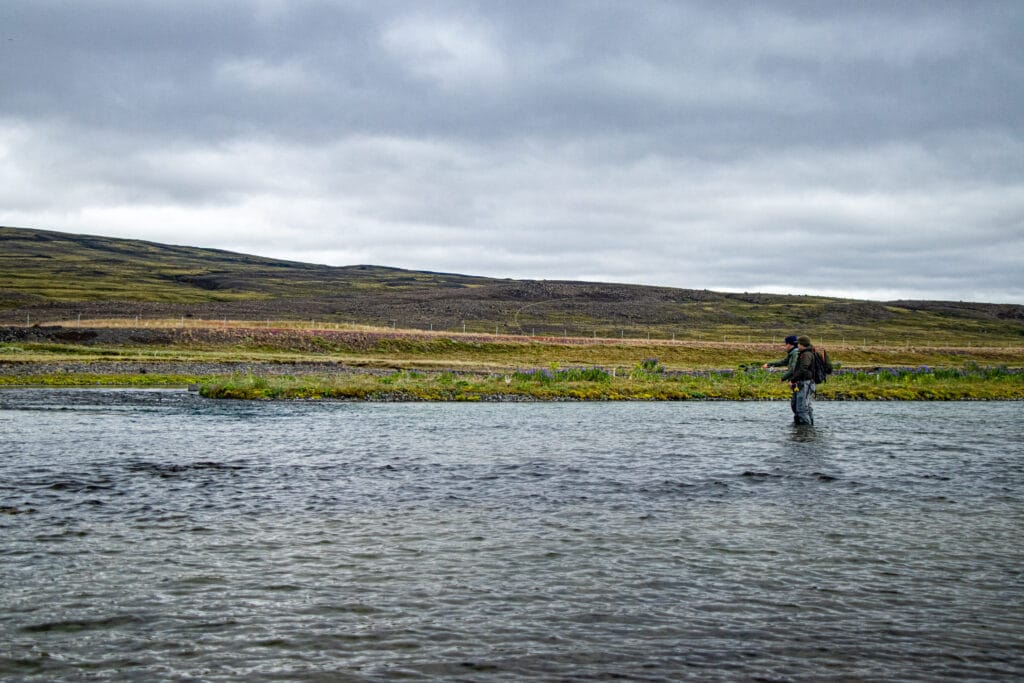
The first few pools we tried yielded little reward for the two of us, so we took the decision to move down river. On our way we passed by as Tim hooked into a char on a deep corner pool, this gave us confidence to stick at it. We parked up at a nice big pool, Hugh took the lower part of the run and main pool body, and I hiked up a little bit to start in the shallows above and work down. Given the conditions, I stuck with my streamer set up but changed the heavy Martin’s Minnow and replaced it with a white and chartreuse rabbit zonker.
Now in the run, I cast across the river on a slight downstream angle. Landing my fly each time on a visibly shallower shelf in the hope that drawing it over the drop of might entice a take. Halfway down the shelf I had a quick snatch at the fly in open water but no hook up. Confidence growing, I continued to cast along the shelf and was rewarded two or three casts later. This time a thumping hit on the fly, and a strong fight from a fish that hung deep. Sliding a beautiful golden and olive coloured 45 cm Arctic char over my net. Soon after Hugh followed up with its much bigger neighbour, a glorious 55 cm char.
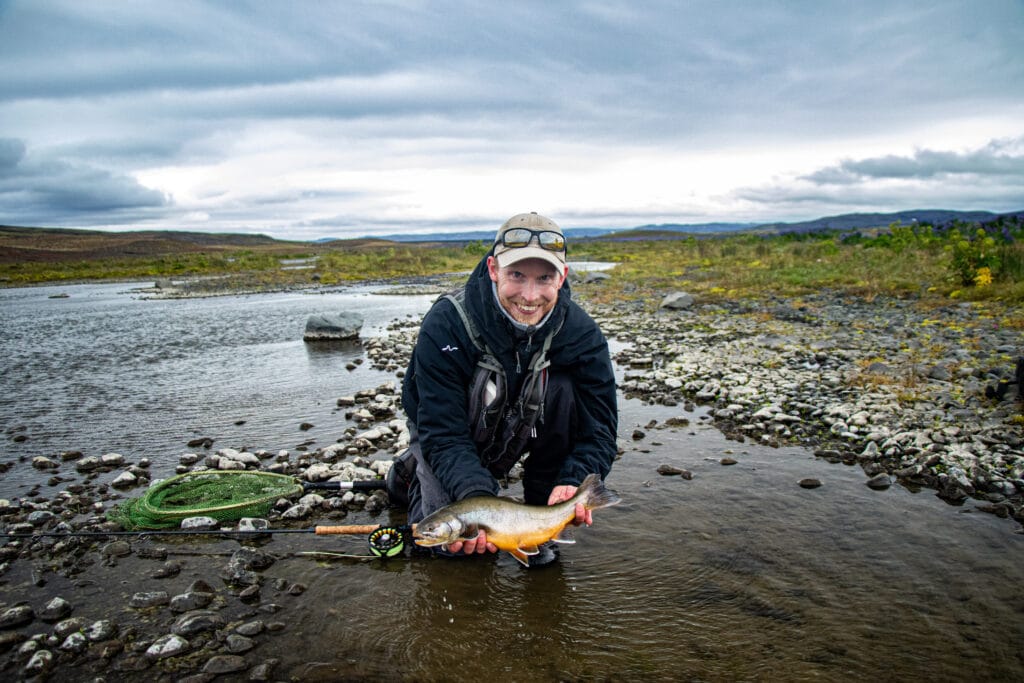
With lunch on the horizon, I had a quick run through two tiny pools. They offered barely 10 casts apiece but had to be worth 5 minutes. The decision nearly paid off too as I saw a huge char charge down my fly. It made one quick grab at the zonker, only to sever several fibres from the tail but remain unhooked. Despite my best efforts and several fly changes, I was unable to move the fish a second time. I resigned myself to lunch and warmed up with hot soup and fresh coffee.
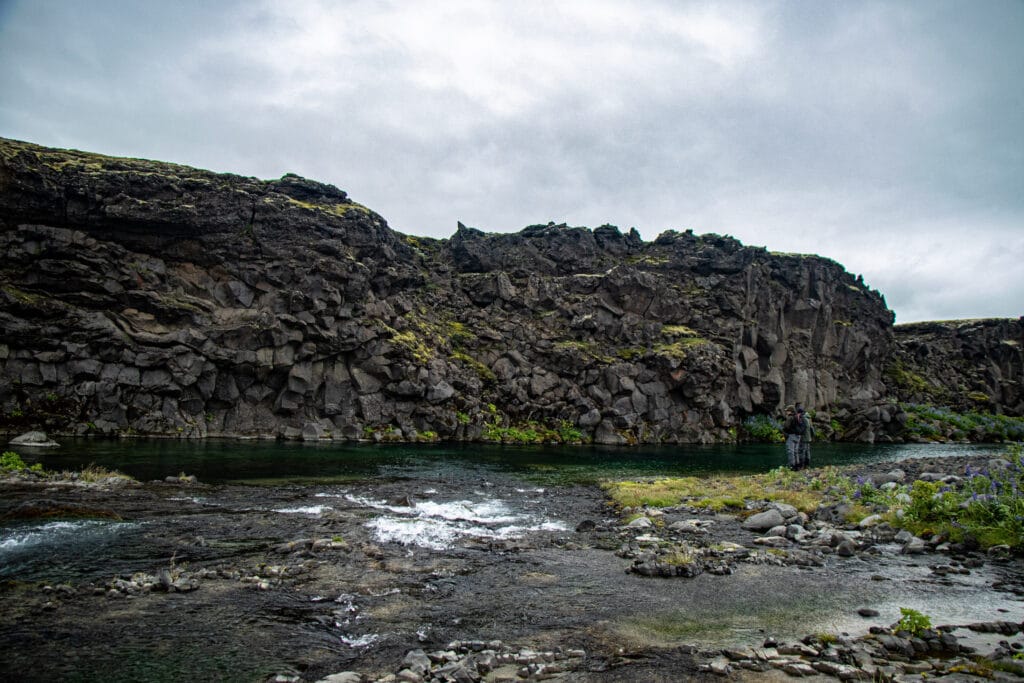
For the afternoon we headed to the uppermost pools, here the river changes nature as rock cliffs and large stones play a greater role in the rivers characteristics. Given the strong winds and horizontal rain, the high stone walls offered temporary shelter, and high vantage points from which to spot trout and char. Also enjoying the shelter was a good hatch of midges interspersed with the odd small caddisfly. Peering into the pool below, it was possible to see the white fin tips of char as the busily worked the pool hoovering up midge larvae and other aquatic insects.
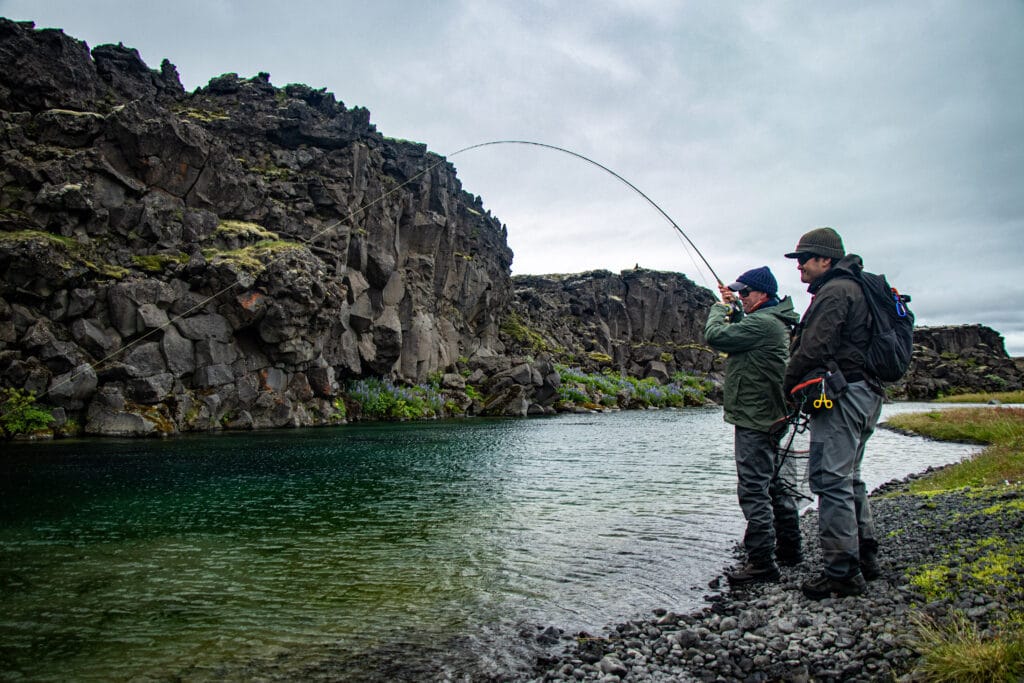
Hugh landed one nice char from the pool, before we decided to walk further upstream to the highest pools. Right at the top, the river narrows into a deep aquarium like pool sandwiched between towering bedrock cliffs. Our eyes scanned the water for any sign of fish, it was hard to see into the pool at times as a swirling wind induced a glaring ripple on the surface. Then, drifting out from under a ledge, a large black shadow came into view. It was a huge brown trout, and despite our best efforts, the broken surface and the sheer depth of the pool meant that we were unable to entice the fish on this occasion.
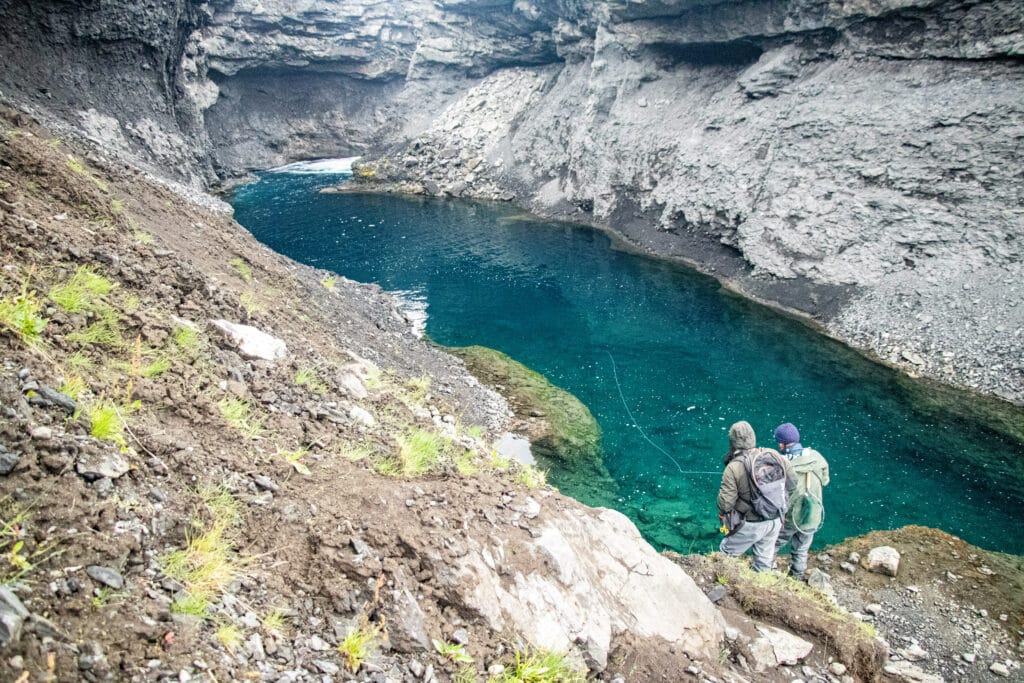
Dropping back down the river, Hugh and I found a small pod of rising char. Lying just at the back of a deep pot, the fish were feeding freely along the edge of a pacey seam line. Hugh, adamant to raise one to his own dry fly, went through most of his fly box. Eventually deceiving a fish with a Fulling Mill size 18 Greased Lightning. The char then shot off downstream before throwing the hook at range. A bittersweet moment, the success of hooking up on a dry but the disappointment of not landing the fish. With that came the end of our day on the water with a tough day on the water report by the others too.
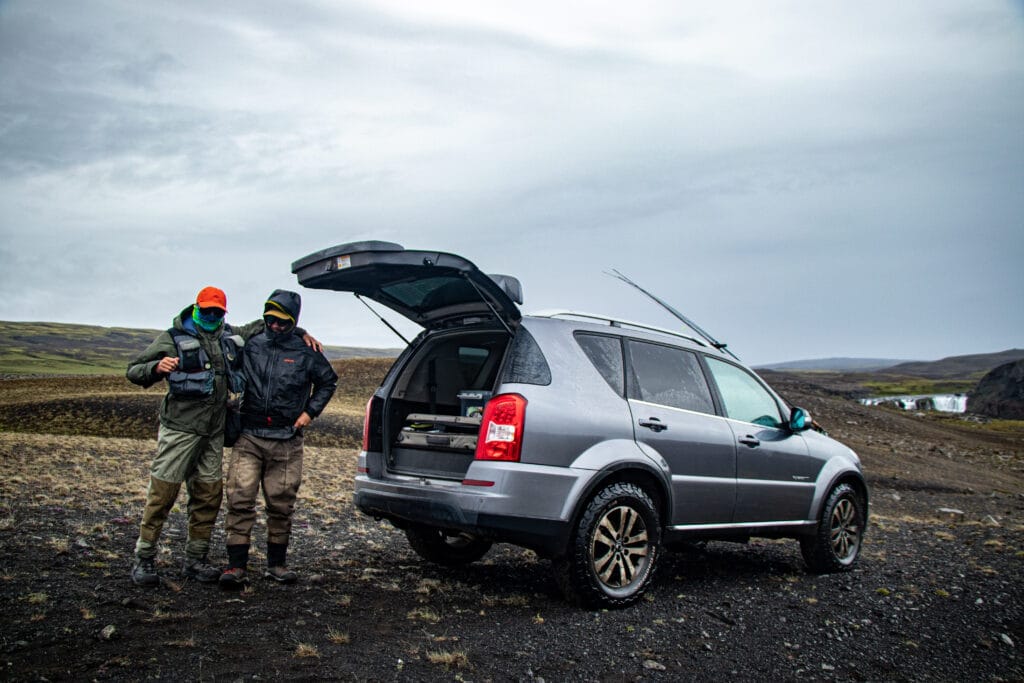
Day three arrived, and it was wet… very wet! Wrestling waders and waterproofs on, I teamed up with Gary and guide Nonny to head back up to the Kaldakvisl. Despite the driving rain, the morning drive was once again blessed by its display of ground nesting birds, with the joyous addition of a ptarmigan grouse taking flight in its full summer plumage.
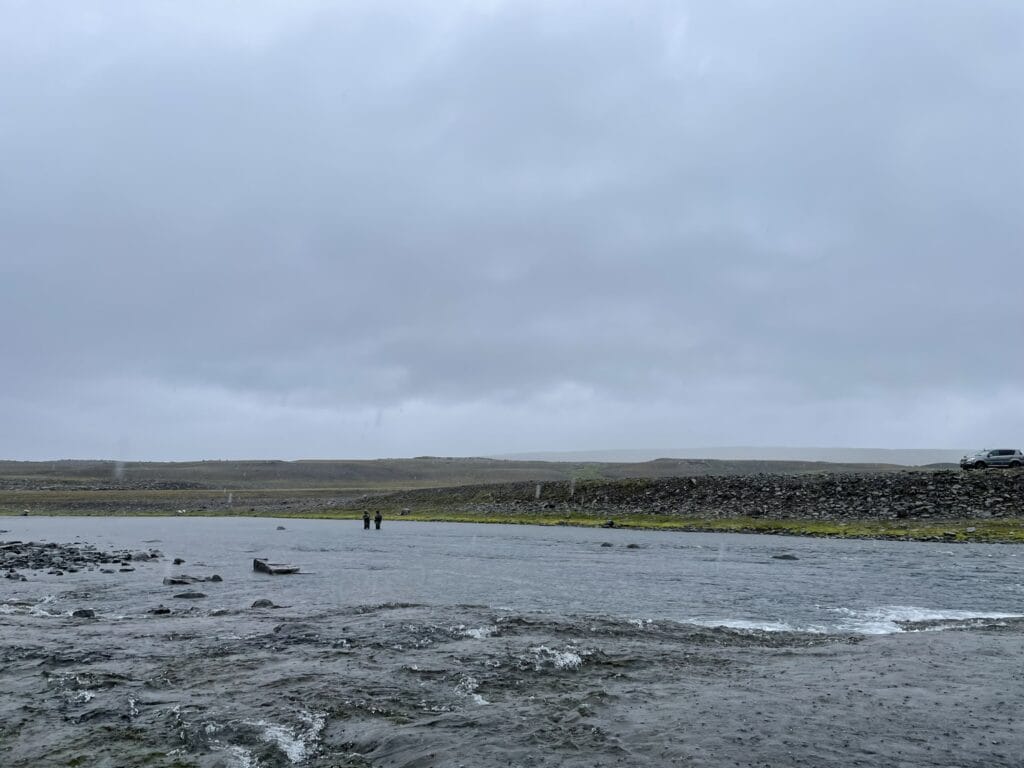
This time we parked up on the lower half of the river to focus on pools 6 to 11 (Midsvaedi and Nefji). This is the section of river where the brown trout are joined by Arctic char that enter the river from the lake lower down. We quickly fished through pools 6 and 7 before settling into pool 8, a long straight pool characterized by a series of giant boulders at the head of it and three water monitoring pipes that stretch up the left bank. As with so many places, it was these pipes that marked a great taking spot with Gary hooking up first. Sadly, losing a nice char as it got downstream of him. A little while later I managed to hook a nice 45 cm brownie from almost the exact same spot on a Big Red nymph.
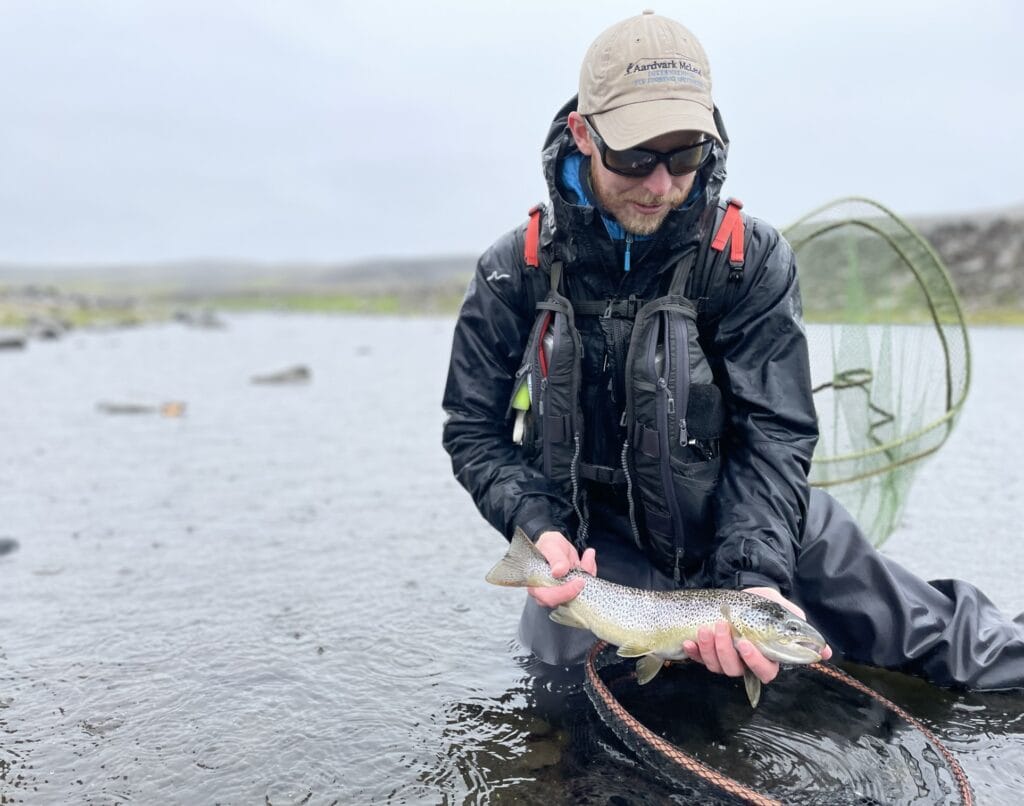
As the day progressed, we fished through more lovely looking pools with little success until we reached pool 10. A pool that richly deserves a name, it will certainly go into my memory banks as one of my favourite fishing pools around the world. A deep pool lying at the bottom of a 500 metre fast shallow boulder-strewn run. The neck of the pool shoots through the boulders before fanning out over smaller pebbles as it gains depth. The right bank has a prominent lava shelf, offering the deeper edge, shallowing up to a grassy edge on the left bank.
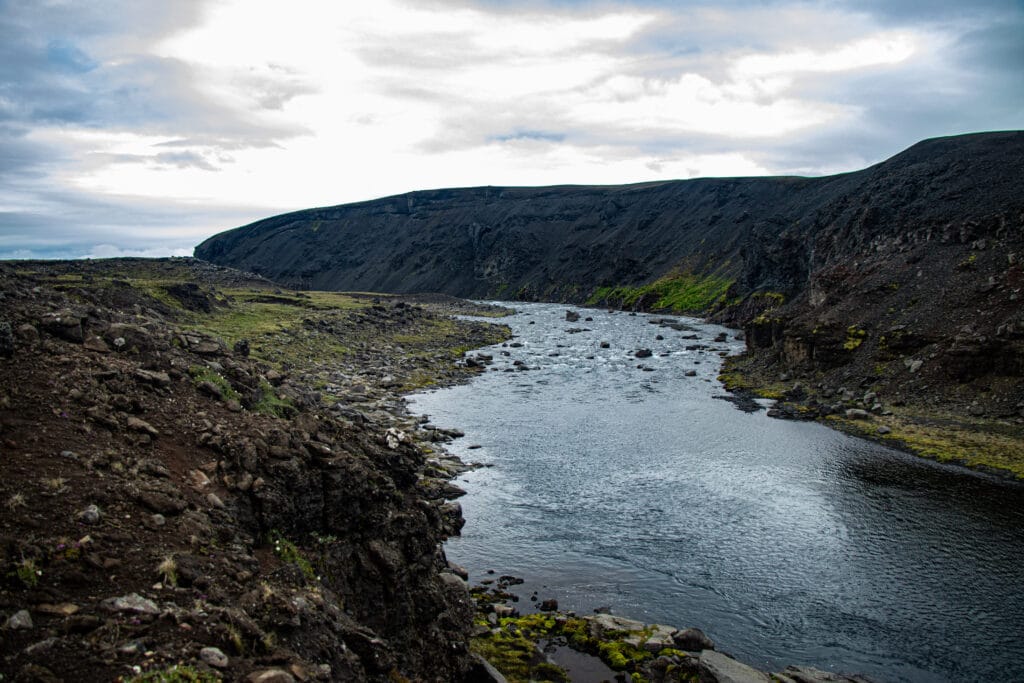
It was along the right bank lava shelf that I noticed a couple of char rise out of the blue. Keeping low, I worked my casts along the edge. Repeating over and over with little joy, I aimed a cast slightly higher. First drift and my indicator dipped away. Striking into one of the char, or so I thought. The fish shot off downstream, holding tight to the lava edge. Running after it, I battled it at the tail of the pool. Persuading the fish up into the shallow water I was surprised to see, not a char but, another good brown trout of 48 cm.
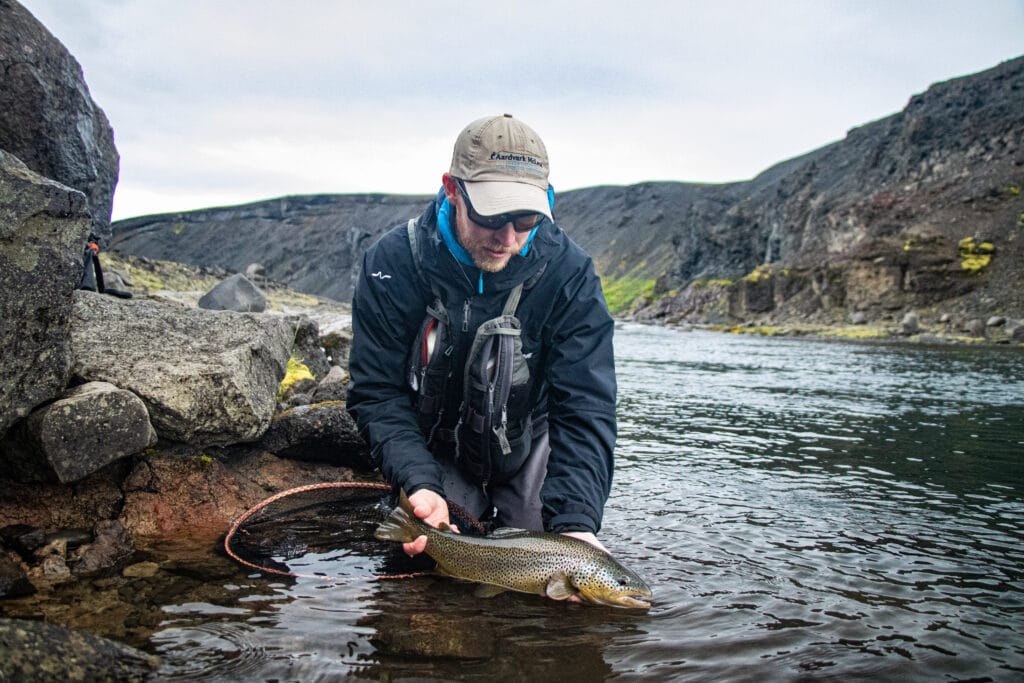
Leaving Gary and Nonny to chase white fin tips in the main pool, I headed upstream to fish the lengthy stretch of pocket water. This would be prime trout habitat back home, so surely it must offer up something. I battled through the heavy flow, zigzagging from rock pot to rock pot. Finally hooking into a fish, the poor thing flew up into the air before resting in my net. A perfectly proportioned ½ lb trout, but not quite what we were there for. I vowed at that point to stick to the pools where the big fish seemed to live.
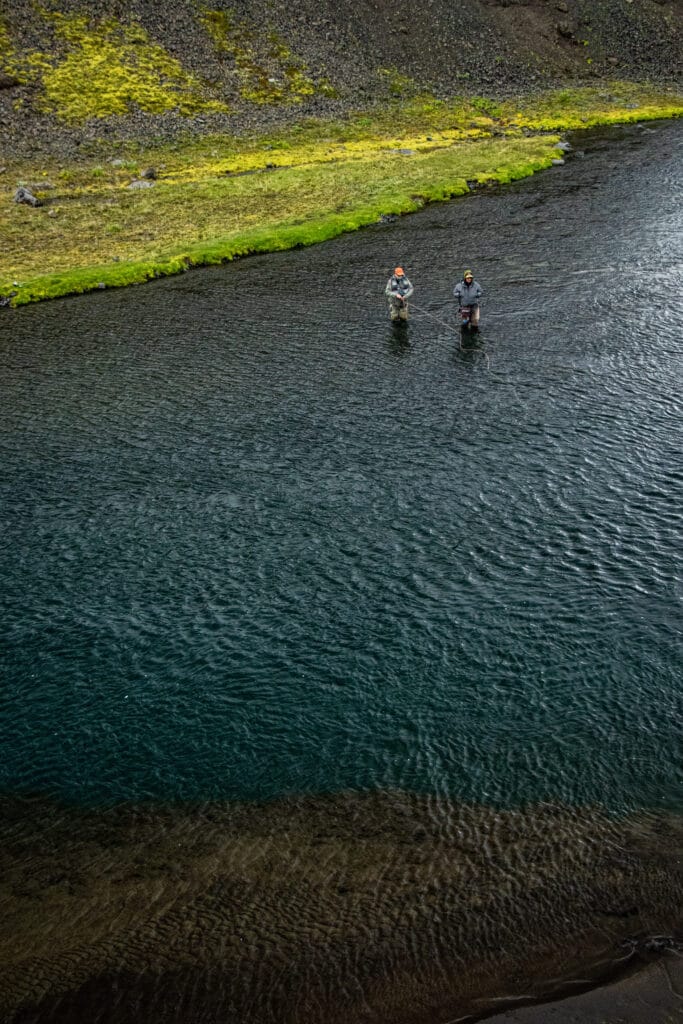
Now with Gary at the head of the pool, I dropped back to the lava shelf just over halfway down and changed to the streamer setup. Due to the sheer depth of the pool, I switched back to the heavy Martin’s Minnow. Within a couple of casts, I saw a char charging down the fly from the clear depths below, but it turned away as the fly approached the shelf. Casting again, the fly got crunched in the middle of the pool. After a hard-fought battle, my biggest char of the trip slid over the net. A 53 cm fish, with rich orange belly and a back as black as the lava sand around it. A totally different looking fish to the paler specimens on the Tungnaa.
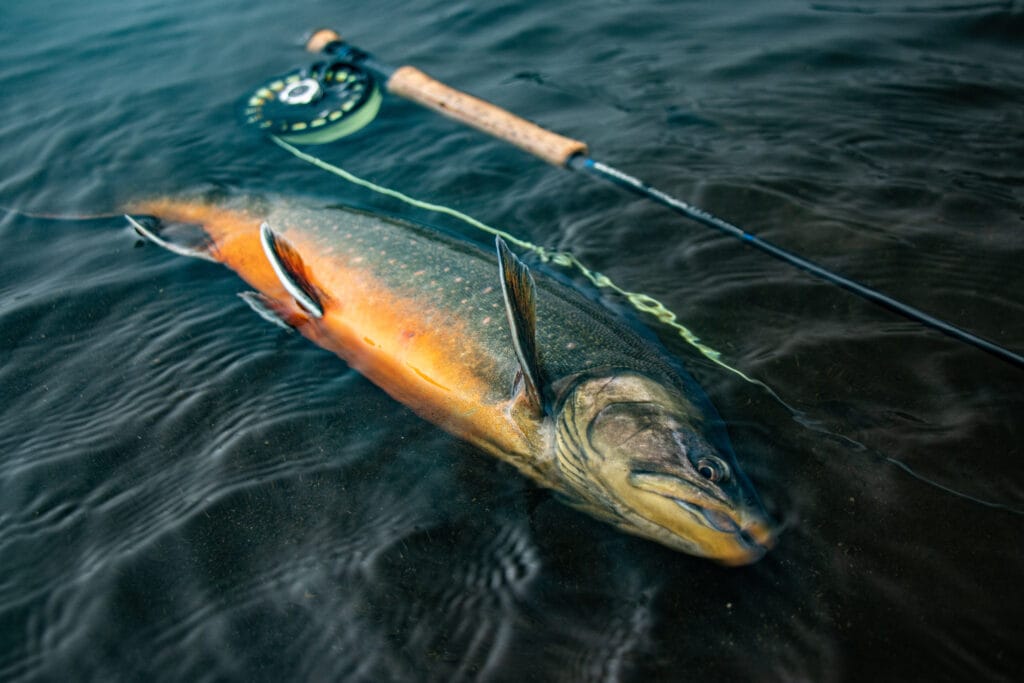
Convinced that the pool still had more to offer, Gary had several casts from the rocky ledge in the hope that the pool would gift us one more char. It didn’t take long before Gary’s streamer was snatched at range. Another impressive battle ensued, with the fish regularly diving under the shark rocky outcrop. Negotiate well, Nonny was able to scoop up another fine Kaldakvisl fish. Another surprise brown trout of 48 cm. We were all smiles as we stripped off our soaking wet rain gear and loaded up into the car with heaters on full blast to go back to the lodge.
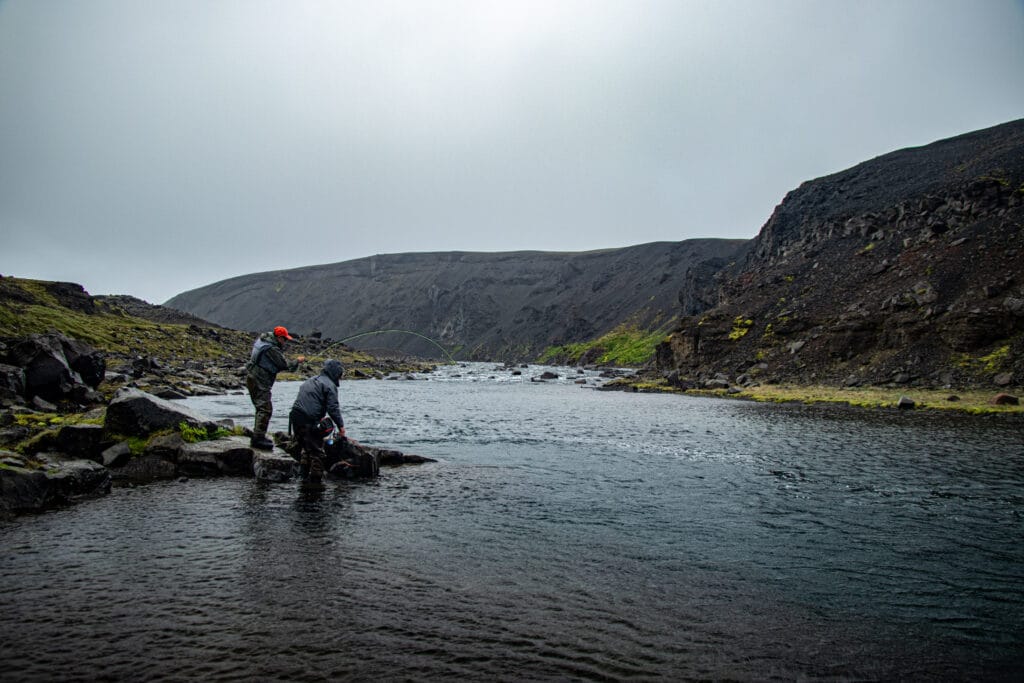
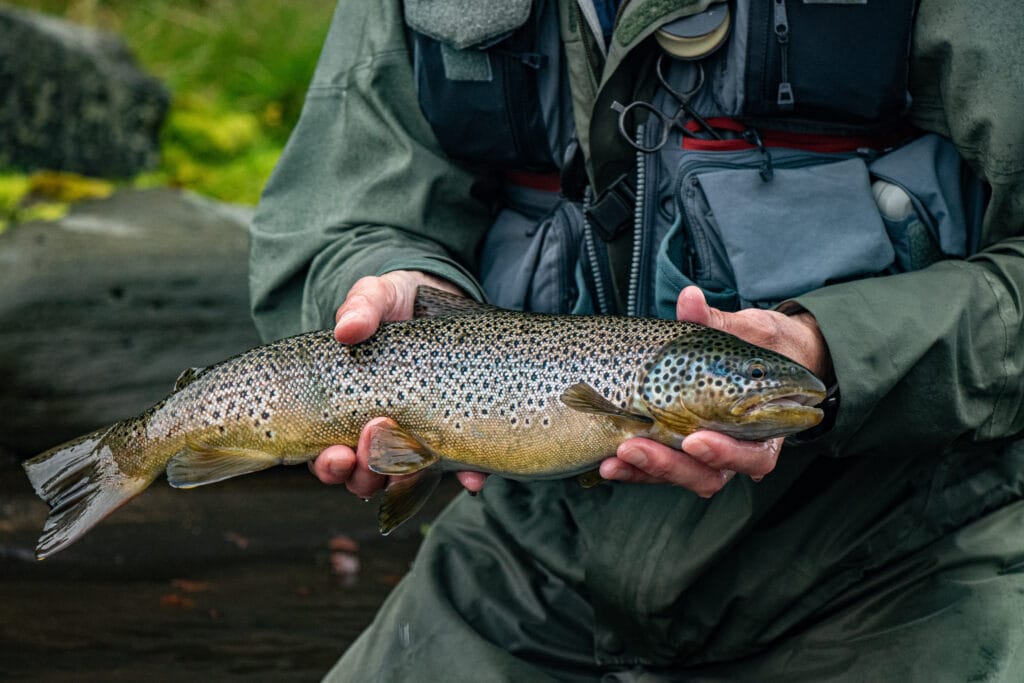
Day four arrived, and with it came a rare break in the strong winds of the previous days. Joining Robert, the coffee master, again and this time John, we returned to the middle Tungnaa. The open valley was still influenced by a southwesterly wind, but here and there the odd char could be seen rising. The rises were less like that of a typical river trout sat on station, and far more akin to a rainbow trout on a reservoir feeding through the wind channels.
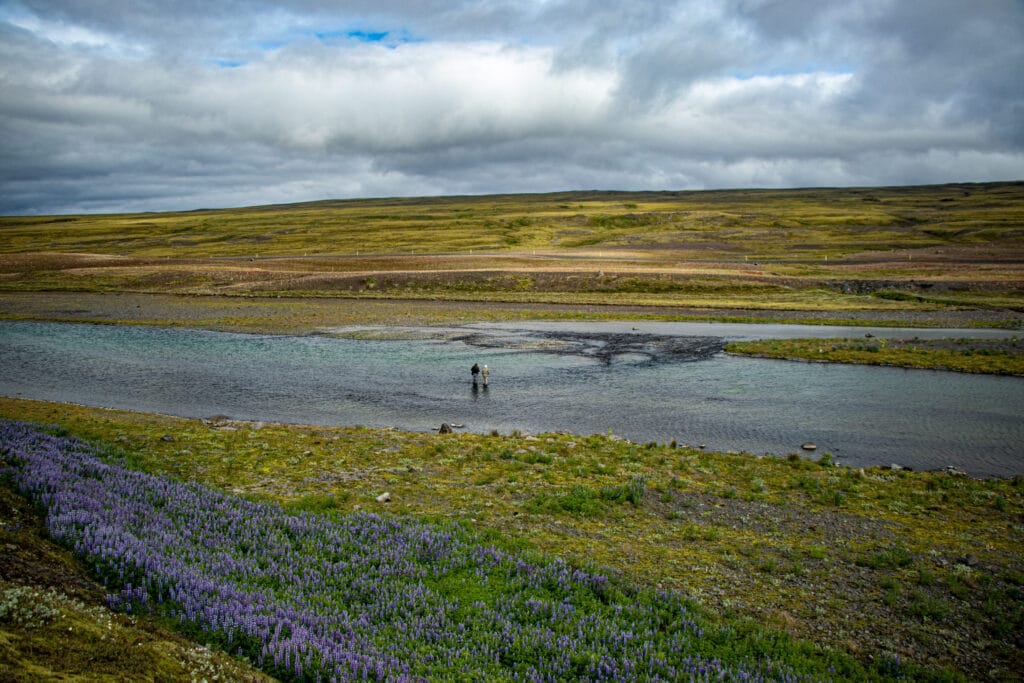
The ever-moving char made presenting a fly in the right place a challenge, I therefore opted for a double dry setup. I had a small black Klinkhammer on the dropper and a size 16 Bibio Hopper on the point. The flies got some interest with several swirls at my offerings but no fish committing. Before long though, the strong winds returned as the morning progressed. This made dry fly fishing supremely difficult, I therefore switched back to my trusted streamer setup and the white and chartreuse zonker from two days prior.
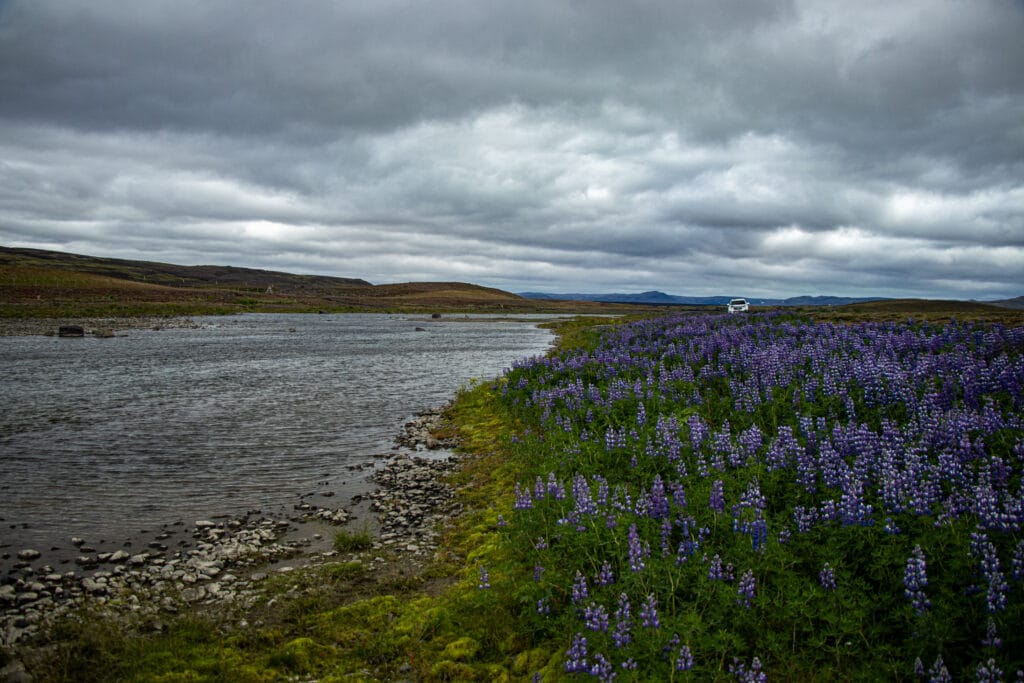
The change brought about an instant reaction. Within about 10 metres of the pool, I had four hookups and landed two pristine Arctic char. Like so many of the fish we encountered on the trip they were in the 45-50 cm category and impressively strong. My streamer setup accounted for one more Arctic char in a small pot in between pools lower down before we broke for lunch.
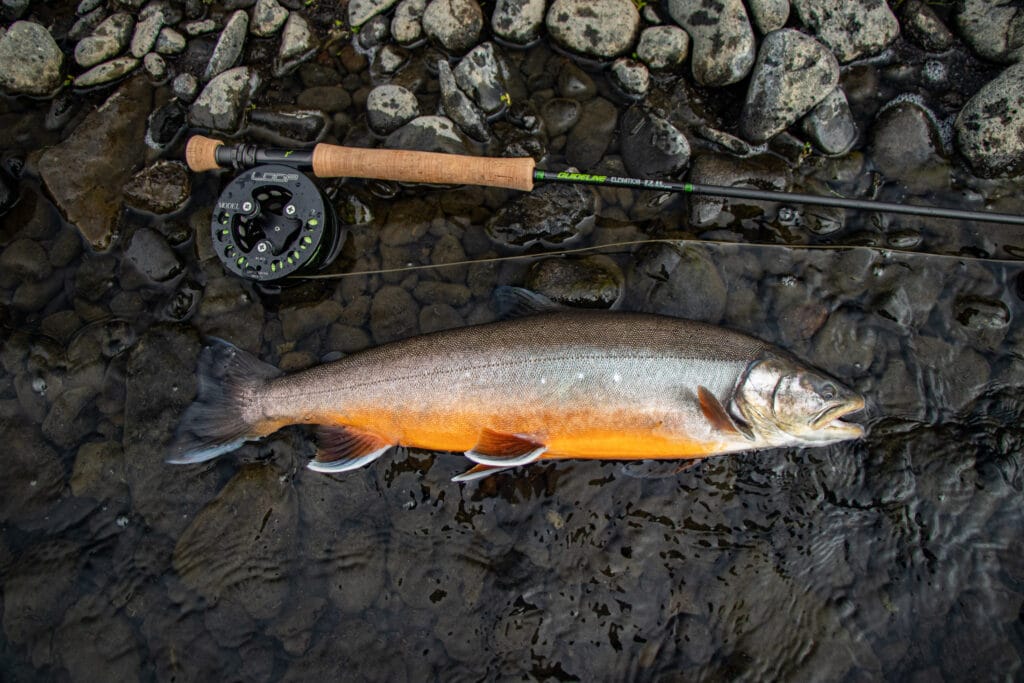
Into the afternoon the winds dropped again as we move up to the uppermost pools once again. John and Robert took the pool where Hugh had been tormented by rising char previously, sure enough the fish were still there and rising with relative frequency.
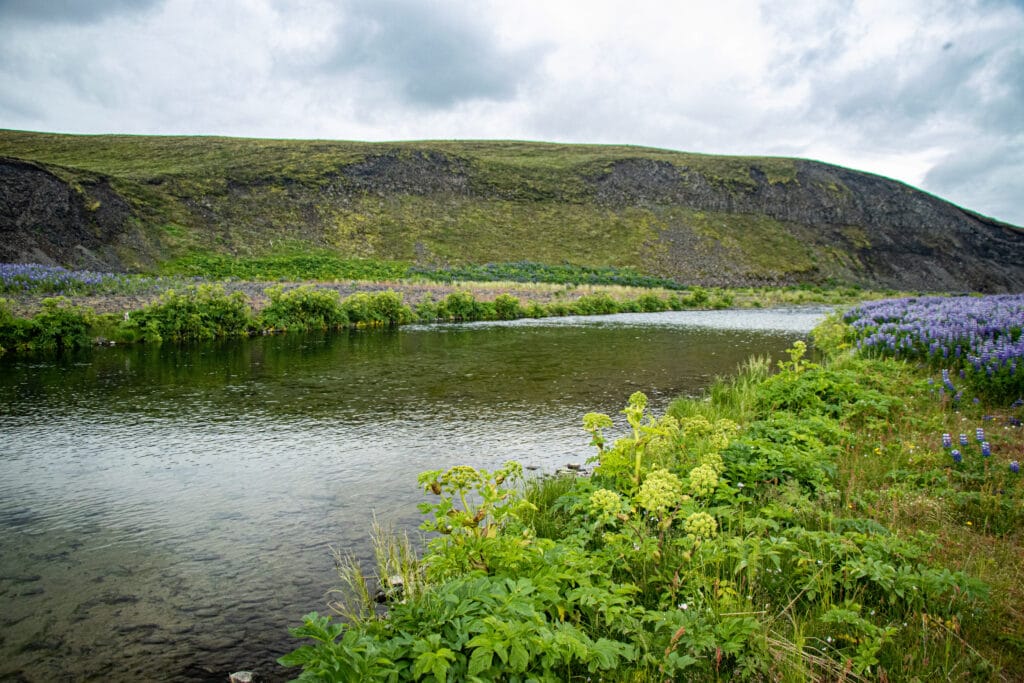
I shuffled upstream a little further to a small, unmarked pool that I had previously stumbled across. Hidden between thick grass and purple lupins, the pool featured a gentle run down the right bank and a 10-metre tail before dropping into the next run. I patiently sat amongst the lupins, and midges, watching the water. Before long, it was possible to see dimpling rises in several different parts of the pool. Armed with my double dry fly setup I proceeded to aim casts at different feeding locations. Again, I had several last-minute refusals. Then, the one cast that I took my eyes off the water, I turned back to see my fly gone and the petering out rings from a recent rise. Needless to say, the fish was gone by the time I reacted, and with that my dry fly shot was gone for the day.
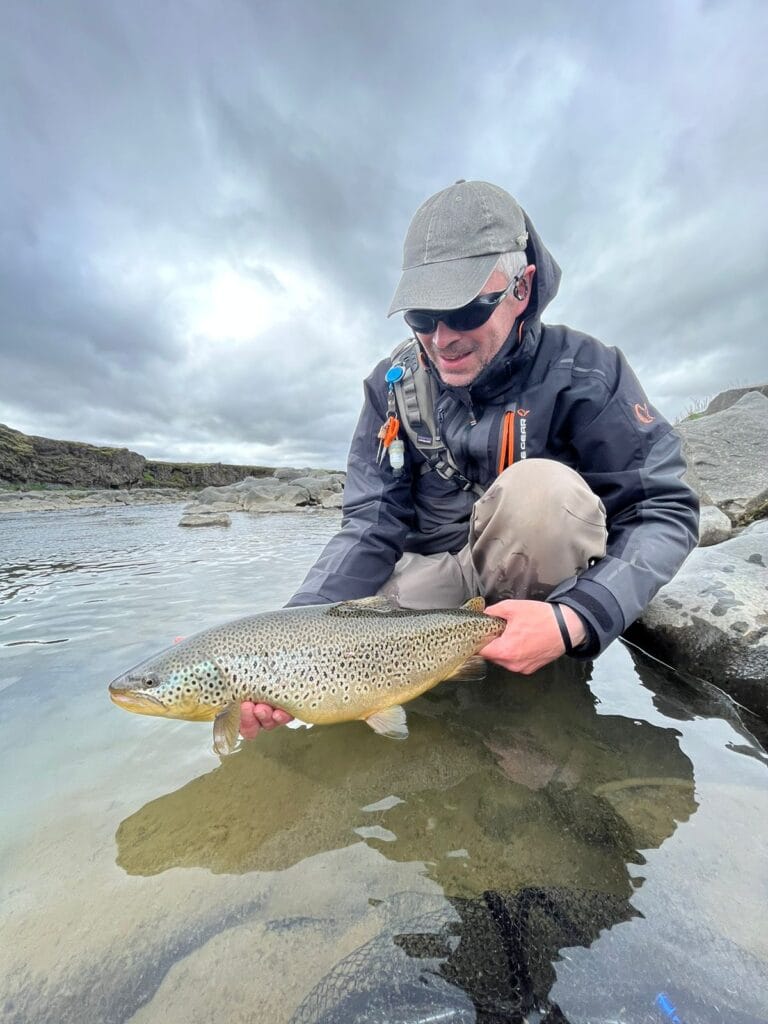
Back at the lodge, all the group reported a variety of fish action. Mark and Gary had a terrific time in Tungnaa’s micro canyon with Mark landing a fine 55 cm brownie. Hugh and Tim took dry fly honours, landing an impressive nine fish between them. A quick return trip to Fellsendavatn that evening proved fruitless, despite the Led Zeppelin blasting out on the journey up there.
The final fishing day was upon us, the whole group were beginning to show the signs of fishing hard in testing conditions. An extra 10 minutes in bed, followed by an extra cup or two of coffee. By the guides’ arrival the focus was back. And it needed to be. Stepping out of the lodge, the ferocious wind did its best to sweep you off your feet.
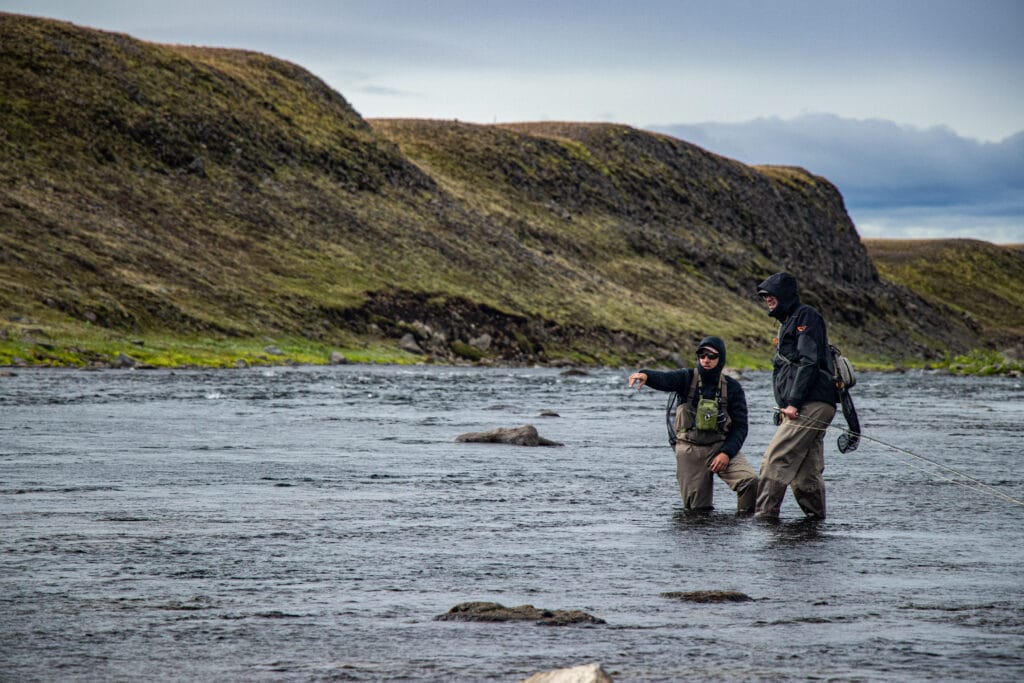
Fully laden in thick all weather fishing gear, I hopped in the car with Mark and guide Jacob to head to the lower pools of the Kaldakvisl. The pools were really interesting to wade and fish, boulders and gravel banks made the pools look classical and easy to read, but hidden subface were a series of bedrock gullies that created unusual lies and required extra thought in the approach. These gullies could be identified by the turquoise hue to the water identifying an area of deeper water.
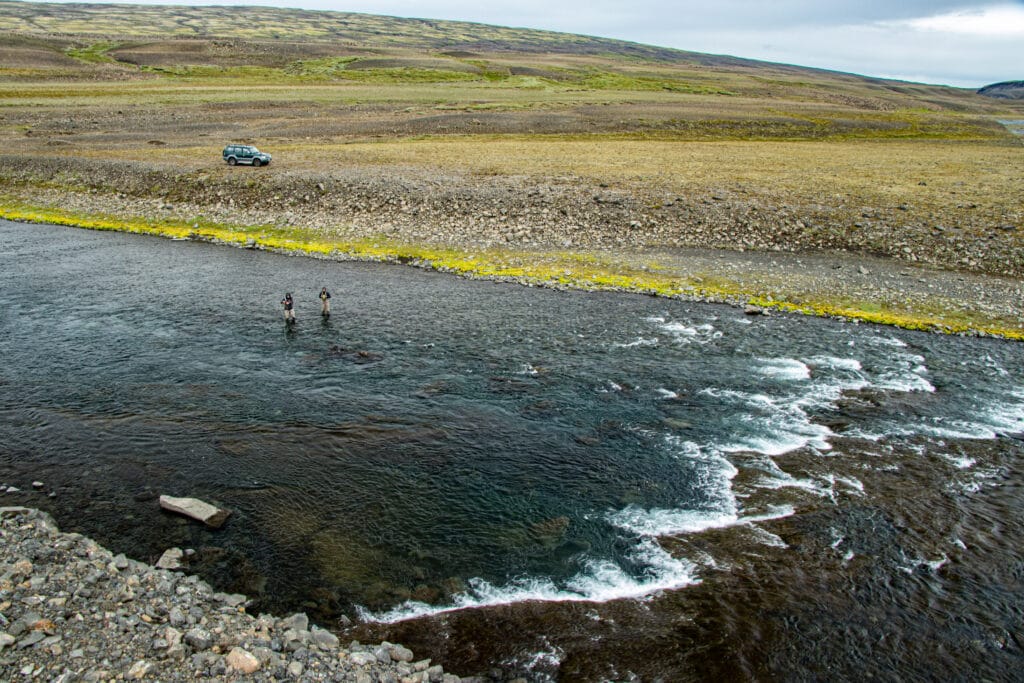
Looking to target these gullies, I opted for my 10’ #4 setup with two heavy nymphs, each with a 4 mm tungsten bead. This was partly to get down but also to counter the strong wind. Placing each cast in the narrow gullies, I watched my pink wool indicator avidly. From time to time, the gullies would open up a little to create small bays and areas of calmer water, it was these places that I tried to hold my drifts for as long as possible. It was one of those areas where I got my first take of the day, a nice brown trout once again falling to the Big Red nymph.
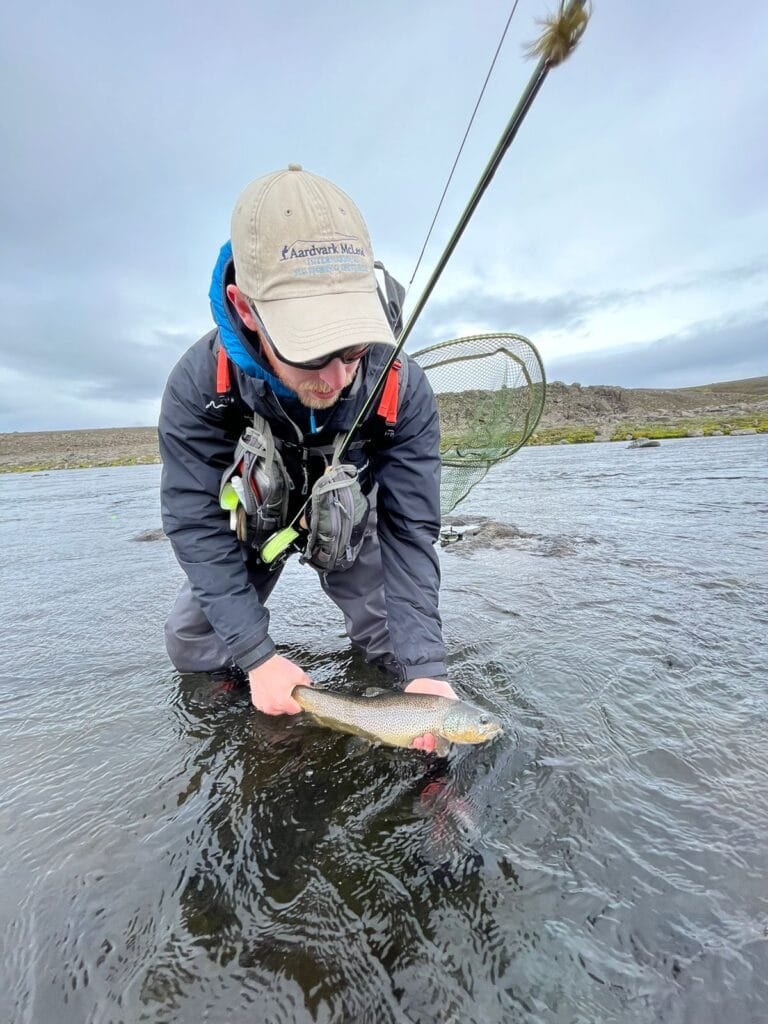
The next few pools yielded little response, albeit beautiful places to stand and cast a fly. It was strange, likely places were proving unsuccessful and the river just seemed even quieter than normal. Reaching my favourite pool from earlier in the week, 10, I was sure we could make something happen. We fished it hard from all angles, I even cast to sighted char and a big brown trout at the head of the pool, but nothing.
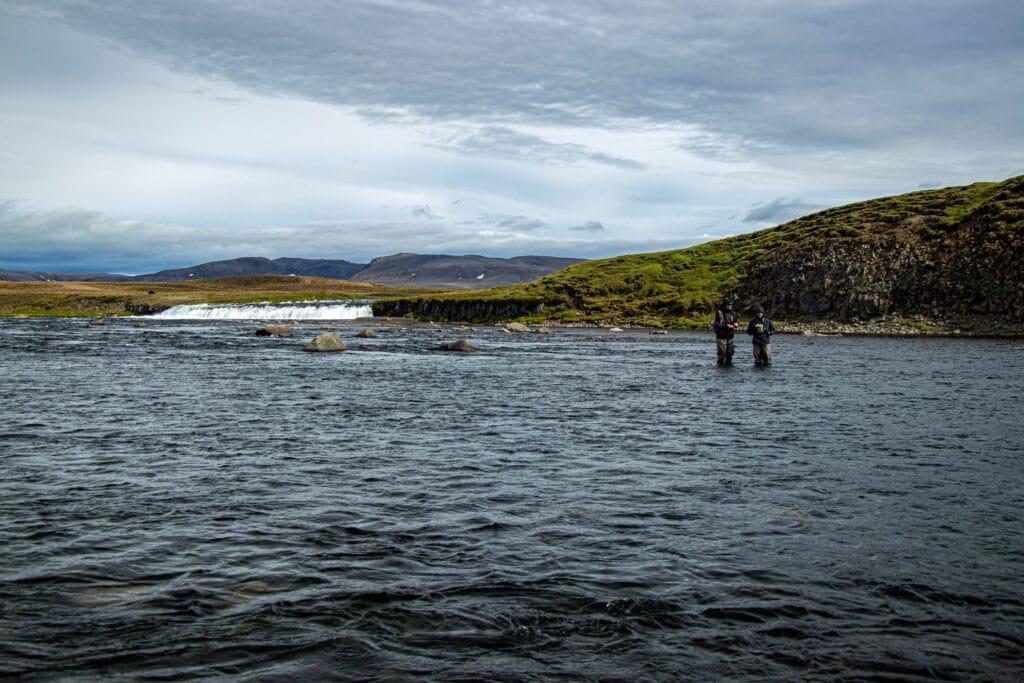
The final day was racing away from us without much success, just a barrage of wind making casting tricky and keeping the air temperature sharp. As one last throw of the dice, Jacob drove us down to a pool creatively named Ós (meaning river mouth). As the name suggests, the pool is the last one on the river before it deposits its clear waters into the cloudy glacial lake that marks the end of Kaldakvisl’s journey.
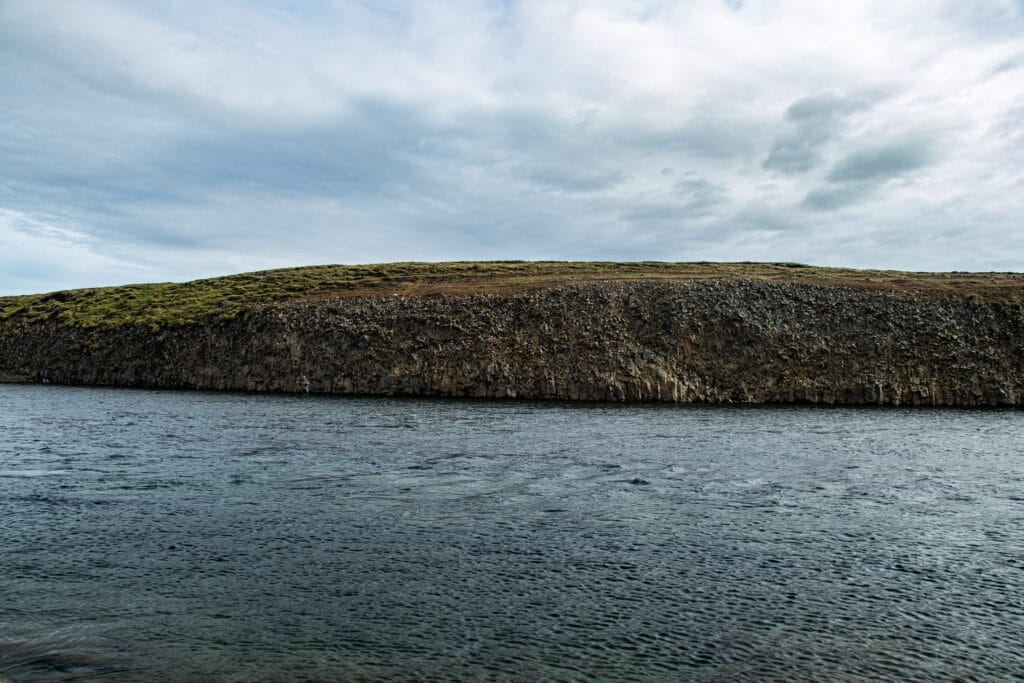
Whilst it was my first time on this pool, I had heard numerous good things about it from the others in the group including about its abundance of Arctic char. The upper most part offered a series of runs and riffles, perfect for fishing nymphs. The left bank ran under high cliffs, making it possible to spot char and call orders down to the angler below. The lower right bank offered a petering out current and good streamer fishing water, it was here that I started fishing. Much like a salmon angler, I would make a cast across the streamy water and work a weighted olive zonker back, before stepping down and casting again.
With each new step, and each new cast hope of something happening increased. It was not long before I felt a quick nab at the tail of my fly, casting again the take was more solid this time. After a strong battle, pulling line into the backing, my best brown trout of the week came to hand. An impressive fish of 55 cm. This was followed by two equally impressive 50 cm char too. All coming within a handful of casts and almost without moving.
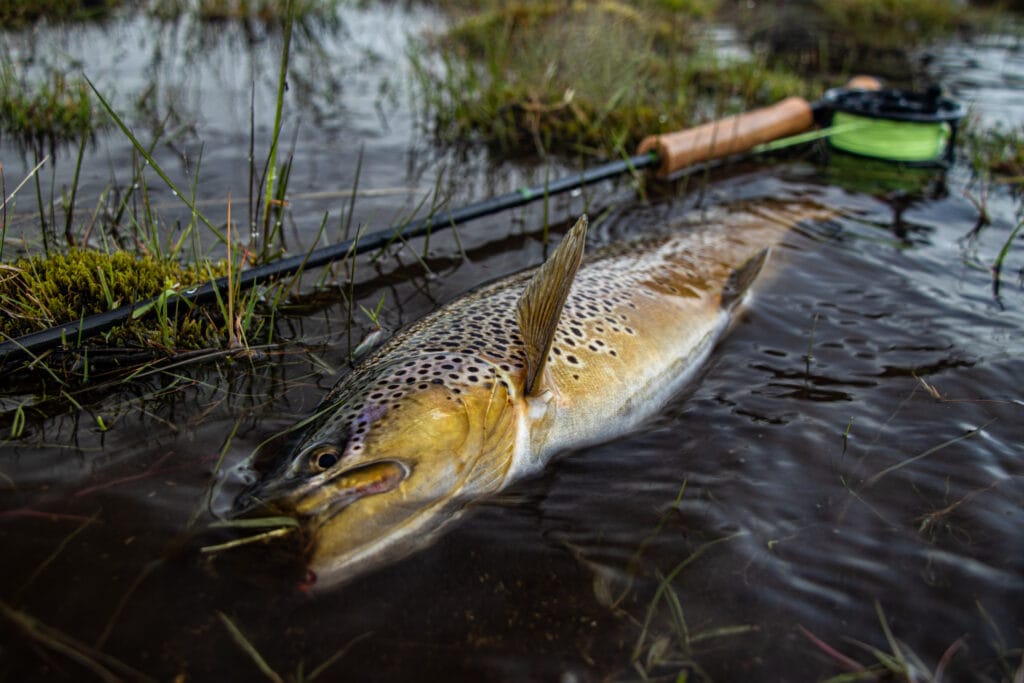
With the fishing day now closing out, we returned to the lodge, but with daylight still on my side I decided to visit the “Cooler”. This is a small bay on the lake just 100 yards from the lodge where a small stream comes in offering a clearer area of water. As the name suggests, this spot is often used by the lodge to catch char for kitchen. Fishing alongside side Jacob, it did not take long before we both caught a pair of smaller fish, probably 30 cm or so. Mission accomplished, we wandered back to the lodge where the whole group enjoyed the final evening by tucking into the remaining wine and gin reserves from the week.
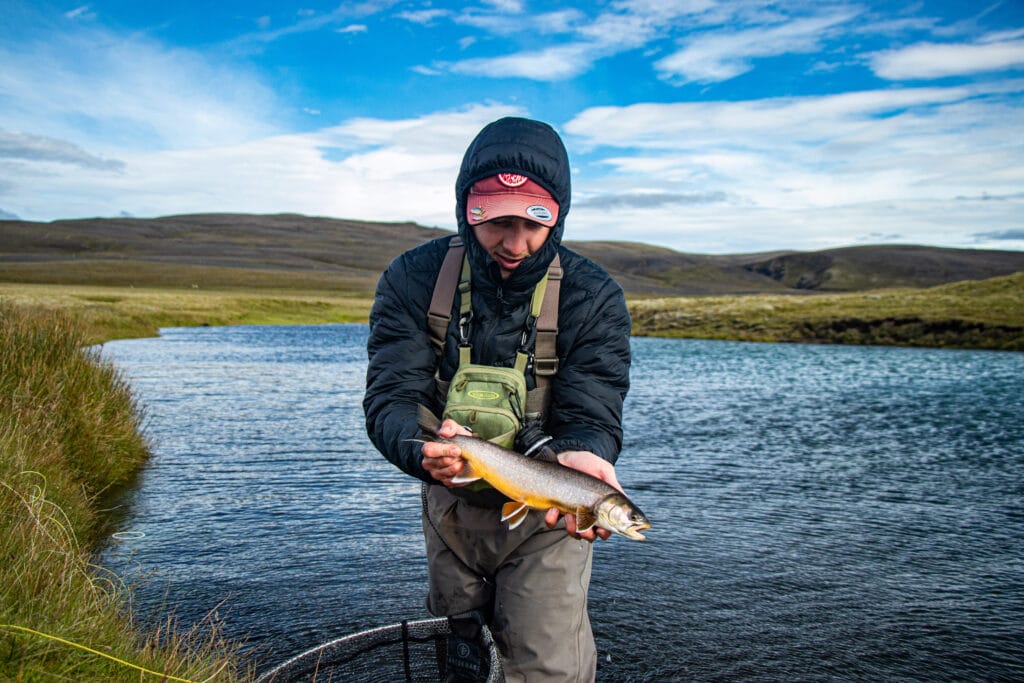
After one of the harder fishing trips to Iceland in terms of weather that I had experienced, it was a given that the final morning saw the sun pop out and not a breath of wind in the air. We were able to joke about on our ride back to the airport aboard Pac Man and I look forward to returning when the weather is more favourable.
For more information about the Southern Highlands and other fishing in Iceland please do not hesitate to contact Peter McLeod or Alex Jardine or call our office on +44(0)1980 847389.
